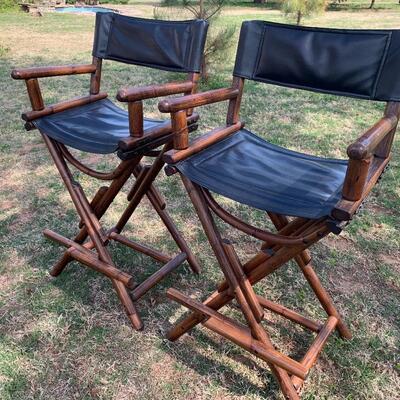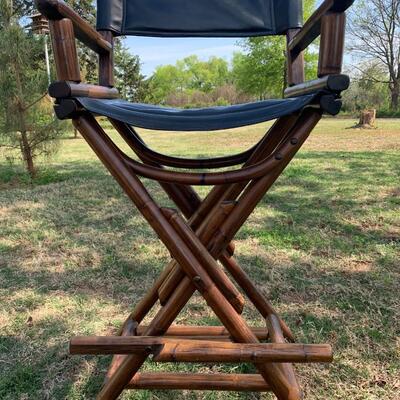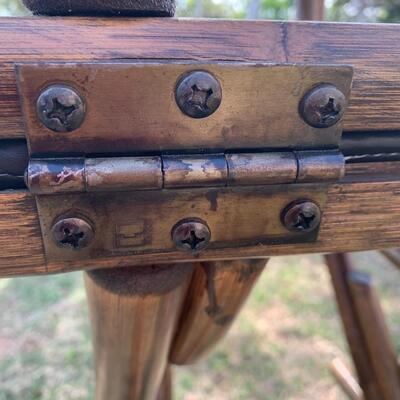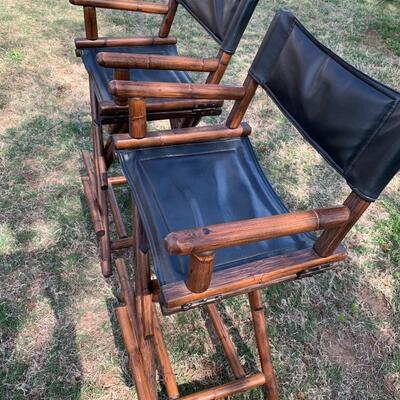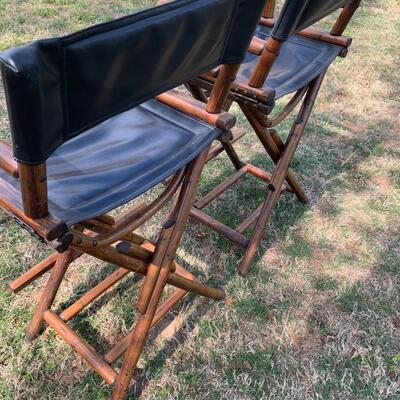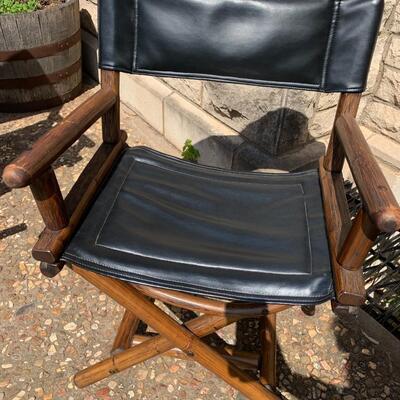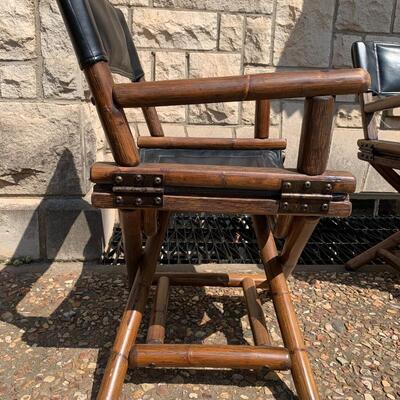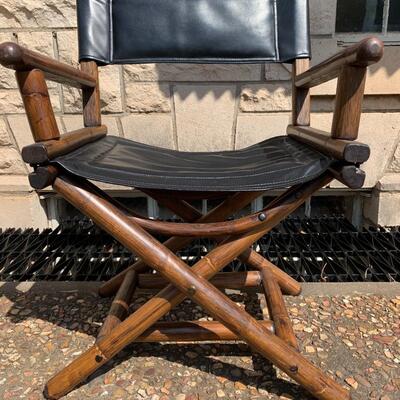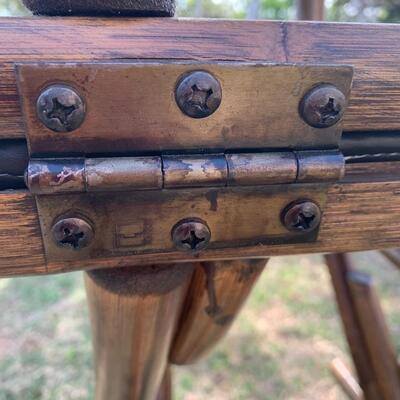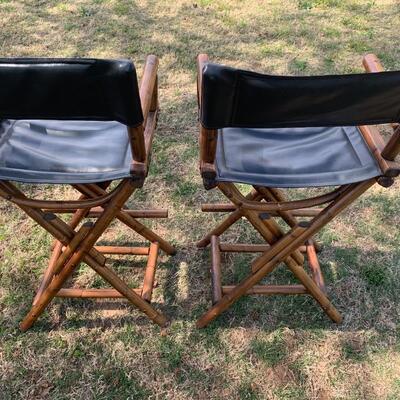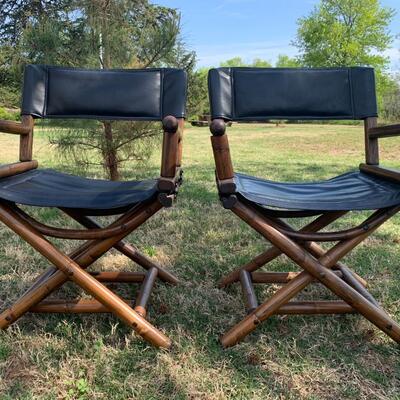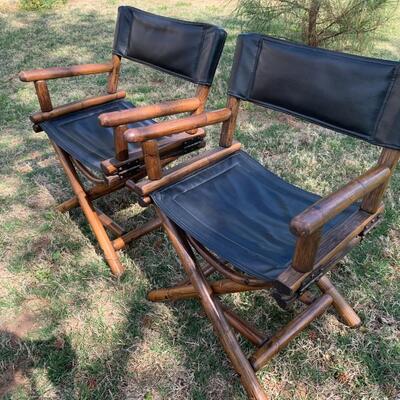-
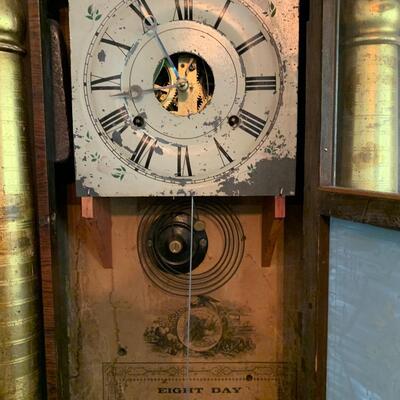
Originally owned by George Washington Lewis who was a circuit judge in the 1820's to 1840's. Clock appears to be in very good condition. Clock was maintained and serviced by an area clock shop near Edmond, OK until the couple who owned it grew to be quite elderly and stopped maintaining it. Buyer pays all shipping and handling. 101 / 591 -
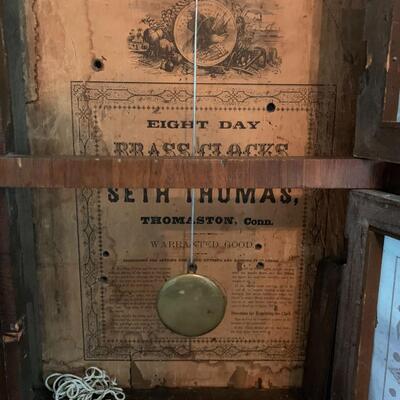
Originally owned by George Washington Lewis who was a circuit judge in the 1820's to 1840's. Clock appears to be in very good condition. Clock was maintained and serviced by an area clock shop near Edmond, OK until the couple who owned it grew to be quite elderly and stopped maintaining it. Buyer pays all shipping and handling. 102 / 591 -
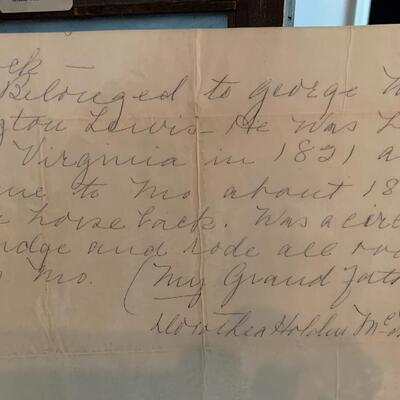
Originally owned by George Washington Lewis who was a circuit judge in the 1820's to 1840's. Clock appears to be in very good condition. Clock was maintained and serviced by an area clock shop near Edmond, OK until the couple who owned it grew to be quite elderly and stopped maintaining it. Buyer pays all shipping and handling. 103 / 591 -
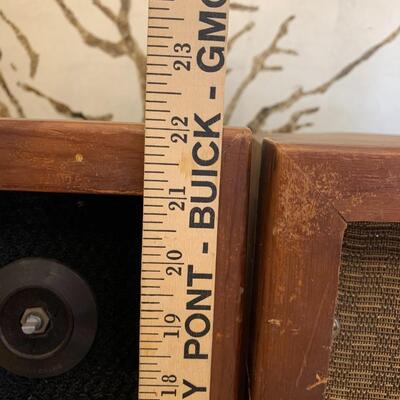
Please note: Additional pictures added on Aug 2nd. The family remembers this jewel playing Flip Wilson, Disney Story albums, ABBA, Olivia Newton John, Bing Crosby Christmas throughout their childhoods in the late 50's, 60's and 70's.... then a family member brought back the latest and greatest of the day after a trip to Korea. Probably has been unplugged ever since then. The unit is untested, but was said to be in fine working condition until the modern day replacement arrived in 1982. (They still have that one, too!) Buyer to pay shipping and handling. Local pickup available. 119 / 591 -
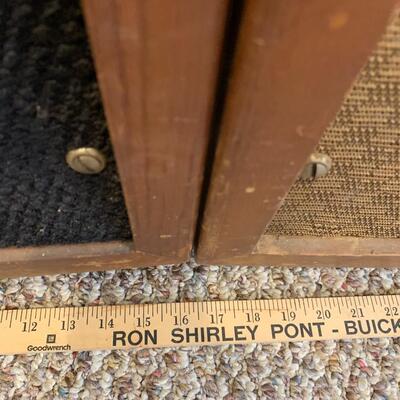
Please note: Additional pictures added on Aug 2nd. The family remembers this jewel playing Flip Wilson, Disney Story albums, ABBA, Olivia Newton John, Bing Crosby Christmas throughout their childhoods in the late 50's, 60's and 70's.... then a family member brought back the latest and greatest of the day after a trip to Korea. Probably has been unplugged ever since then. The unit is untested, but was said to be in fine working condition until the modern day replacement arrived in 1982. (They still have that one, too!) Buyer to pay shipping and handling. Local pickup available. 120 / 591 -
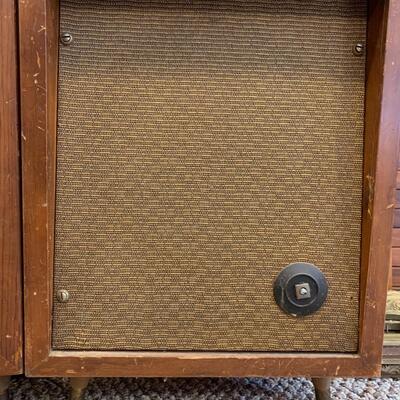
Please note: Additional pictures added on Aug 2nd. The family remembers this jewel playing Flip Wilson, Disney Story albums, ABBA, Olivia Newton John, Bing Crosby Christmas throughout their childhoods in the late 50's, 60's and 70's.... then a family member brought back the latest and greatest of the day after a trip to Korea. Probably has been unplugged ever since then. The unit is untested, but was said to be in fine working condition until the modern day replacement arrived in 1982. (They still have that one, too!) Buyer to pay shipping and handling. Local pickup available. 121 / 591 -
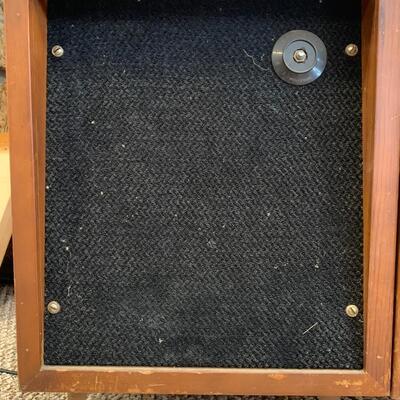
Please note: Additional pictures added on Aug 2nd. The family remembers this jewel playing Flip Wilson, Disney Story albums, ABBA, Olivia Newton John, Bing Crosby Christmas throughout their childhoods in the late 50's, 60's and 70's.... then a family member brought back the latest and greatest of the day after a trip to Korea. Probably has been unplugged ever since then. The unit is untested, but was said to be in fine working condition until the modern day replacement arrived in 1982. (They still have that one, too!) Buyer to pay shipping and handling. Local pickup available. 122 / 591 -
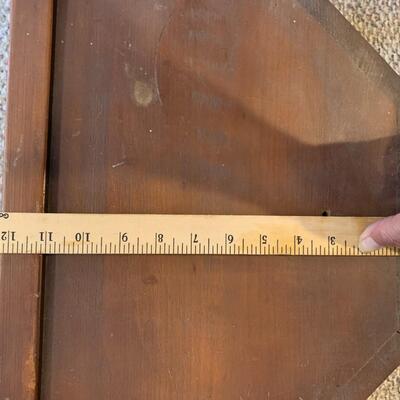
Please note: Additional pictures added on Aug 2nd. The family remembers this jewel playing Flip Wilson, Disney Story albums, ABBA, Olivia Newton John, Bing Crosby Christmas throughout their childhoods in the late 50's, 60's and 70's.... then a family member brought back the latest and greatest of the day after a trip to Korea. Probably has been unplugged ever since then. The unit is untested, but was said to be in fine working condition until the modern day replacement arrived in 1982. (They still have that one, too!) Buyer to pay shipping and handling. Local pickup available. 123 / 591 -
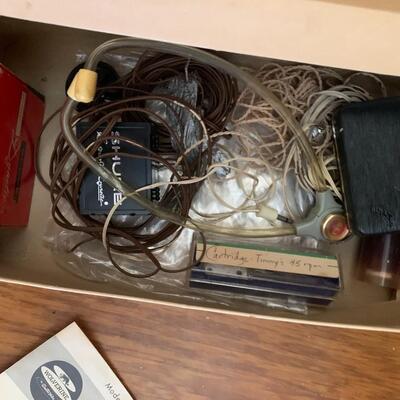
Please note: Additional pictures added on Aug 2nd. The family remembers this jewel playing Flip Wilson, Disney Story albums, ABBA, Olivia Newton John, Bing Crosby Christmas throughout their childhoods in the late 50's, 60's and 70's.... then a family member brought back the latest and greatest of the day after a trip to Korea. Probably has been unplugged ever since then. The unit is untested, but was said to be in fine working condition until the modern day replacement arrived in 1982. (They still have that one, too!) Buyer to pay shipping and handling. Local pickup available. 124 / 591 -
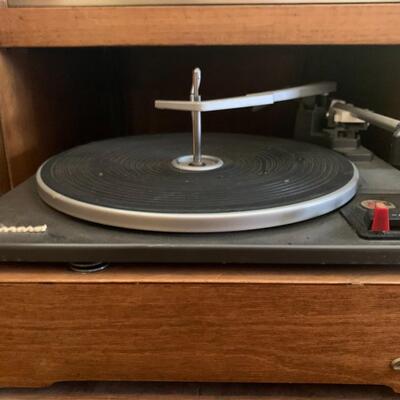
Please note: Additional pictures added on Aug 2nd. The family remembers this jewel playing Flip Wilson, Disney Story albums, ABBA, Olivia Newton John, Bing Crosby Christmas throughout their childhoods in the late 50's, 60's and 70's.... then a family member brought back the latest and greatest of the day after a trip to Korea. Probably has been unplugged ever since then. The unit is untested, but was said to be in fine working condition until the modern day replacement arrived in 1982. (They still have that one, too!) Buyer to pay shipping and handling. Local pickup available. 125 / 591 -
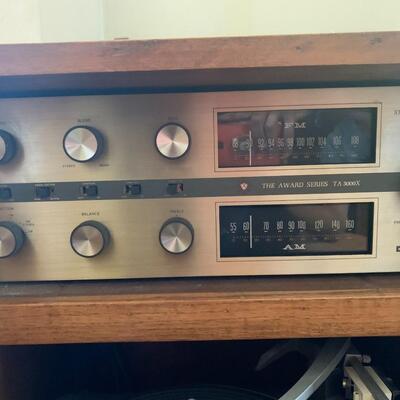
Please note: Additional pictures added on Aug 2nd. The family remembers this jewel playing Flip Wilson, Disney Story albums, ABBA, Olivia Newton John, Bing Crosby Christmas throughout their childhoods in the late 50's, 60's and 70's.... then a family member brought back the latest and greatest of the day after a trip to Korea. Probably has been unplugged ever since then. The unit is untested, but was said to be in fine working condition until the modern day replacement arrived in 1982. (They still have that one, too!) Buyer to pay shipping and handling. Local pickup available. 126 / 591 -
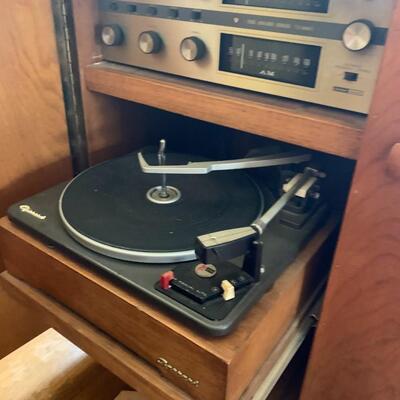
Please note: Additional pictures added on Aug 2nd. The family remembers this jewel playing Flip Wilson, Disney Story albums, ABBA, Olivia Newton John, Bing Crosby Christmas throughout their childhoods in the late 50's, 60's and 70's.... then a family member brought back the latest and greatest of the day after a trip to Korea. Probably has been unplugged ever since then. The unit is untested, but was said to be in fine working condition until the modern day replacement arrived in 1982. (They still have that one, too!) Buyer to pay shipping and handling. Local pickup available. 127 / 591 -
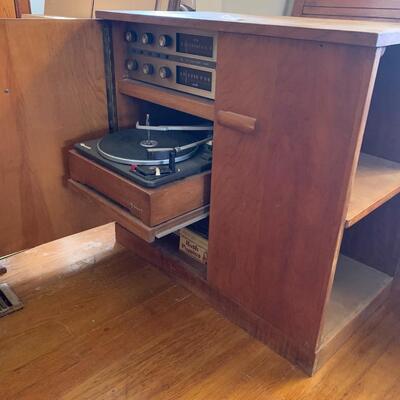
Please note: Additional pictures added on Aug 2nd. The family remembers this jewel playing Flip Wilson, Disney Story albums, ABBA, Olivia Newton John, Bing Crosby Christmas throughout their childhoods in the late 50's, 60's and 70's.... then a family member brought back the latest and greatest of the day after a trip to Korea. Probably has been unplugged ever since then. The unit is untested, but was said to be in fine working condition until the modern day replacement arrived in 1982. (They still have that one, too!) Buyer to pay shipping and handling. Local pickup available. 128 / 591 -
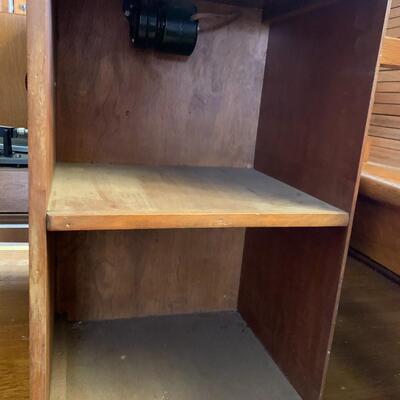
Please note: Additional pictures added on Aug 2nd. The family remembers this jewel playing Flip Wilson, Disney Story albums, ABBA, Olivia Newton John, Bing Crosby Christmas throughout their childhoods in the late 50's, 60's and 70's.... then a family member brought back the latest and greatest of the day after a trip to Korea. Probably has been unplugged ever since then. The unit is untested, but was said to be in fine working condition until the modern day replacement arrived in 1982. (They still have that one, too!) Buyer to pay shipping and handling. Local pickup available. 129 / 591 -

Please note: Additional pictures added on Aug 2nd. The family remembers this jewel playing Flip Wilson, Disney Story albums, ABBA, Olivia Newton John, Bing Crosby Christmas throughout their childhoods in the late 50's, 60's and 70's.... then a family member brought back the latest and greatest of the day after a trip to Korea. Probably has been unplugged ever since then. The unit is untested, but was said to be in fine working condition until the modern day replacement arrived in 1982. (They still have that one, too!) Buyer to pay shipping and handling. Local pickup available. 130 / 591 -
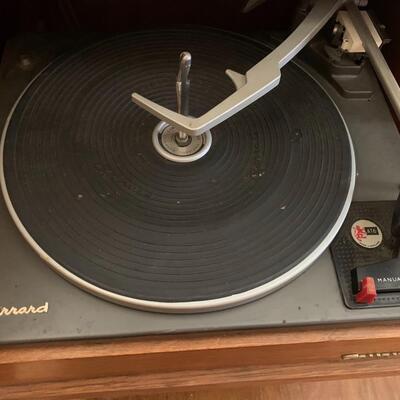
Please note: Additional pictures added on Aug 2nd. The family remembers this jewel playing Flip Wilson, Disney Story albums, ABBA, Olivia Newton John, Bing Crosby Christmas throughout their childhoods in the late 50's, 60's and 70's.... then a family member brought back the latest and greatest of the day after a trip to Korea. Probably has been unplugged ever since then. The unit is untested, but was said to be in fine working condition until the modern day replacement arrived in 1982. (They still have that one, too!) Buyer to pay shipping and handling. Local pickup available. 131 / 591 -
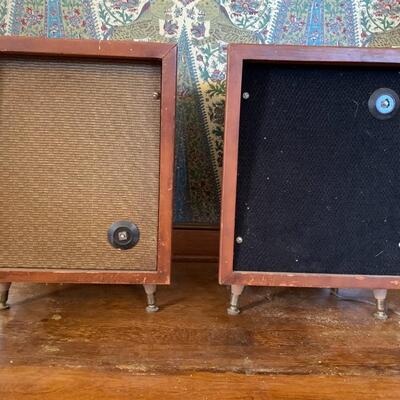
Please note: Additional pictures added on Aug 2nd. The family remembers this jewel playing Flip Wilson, Disney Story albums, ABBA, Olivia Newton John, Bing Crosby Christmas throughout their childhoods in the late 50's, 60's and 70's.... then a family member brought back the latest and greatest of the day after a trip to Korea. Probably has been unplugged ever since then. The unit is untested, but was said to be in fine working condition until the modern day replacement arrived in 1982. (They still have that one, too!) Buyer to pay shipping and handling. Local pickup available. 132 / 591 -
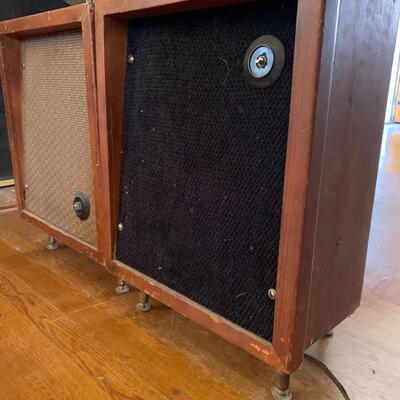
Please note: Additional pictures added on Aug 2nd. The family remembers this jewel playing Flip Wilson, Disney Story albums, ABBA, Olivia Newton John, Bing Crosby Christmas throughout their childhoods in the late 50's, 60's and 70's.... then a family member brought back the latest and greatest of the day after a trip to Korea. Probably has been unplugged ever since then. The unit is untested, but was said to be in fine working condition until the modern day replacement arrived in 1982. (They still have that one, too!) Buyer to pay shipping and handling. Local pickup available. 133 / 591 -
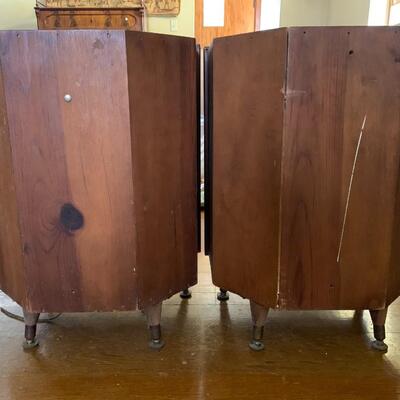
Please note: Additional pictures added on Aug 2nd. The family remembers this jewel playing Flip Wilson, Disney Story albums, ABBA, Olivia Newton John, Bing Crosby Christmas throughout their childhoods in the late 50's, 60's and 70's.... then a family member brought back the latest and greatest of the day after a trip to Korea. Probably has been unplugged ever since then. The unit is untested, but was said to be in fine working condition until the modern day replacement arrived in 1982. (They still have that one, too!) Buyer to pay shipping and handling. Local pickup available. 134 / 591 -
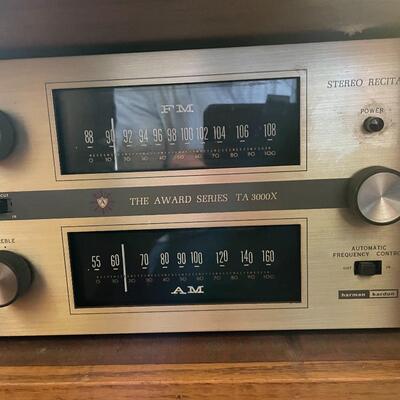
Please note: Additional pictures added on Aug 2nd. The family remembers this jewel playing Flip Wilson, Disney Story albums, ABBA, Olivia Newton John, Bing Crosby Christmas throughout their childhoods in the late 50's, 60's and 70's.... then a family member brought back the latest and greatest of the day after a trip to Korea. Probably has been unplugged ever since then. The unit is untested, but was said to be in fine working condition until the modern day replacement arrived in 1982. (They still have that one, too!) Buyer to pay shipping and handling. Local pickup available. 135 / 591 -
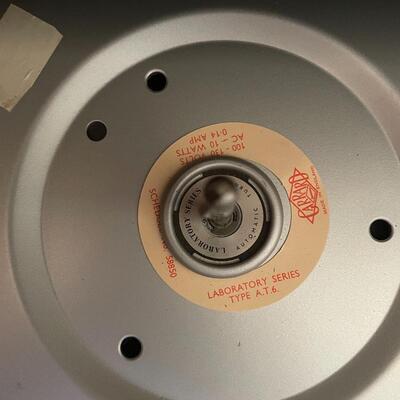
Please note: Additional pictures added on Aug 2nd. The family remembers this jewel playing Flip Wilson, Disney Story albums, ABBA, Olivia Newton John, Bing Crosby Christmas throughout their childhoods in the late 50's, 60's and 70's.... then a family member brought back the latest and greatest of the day after a trip to Korea. Probably has been unplugged ever since then. The unit is untested, but was said to be in fine working condition until the modern day replacement arrived in 1982. (They still have that one, too!) Buyer to pay shipping and handling. Local pickup available. 136 / 591 -

Please note: Additional pictures added on Aug 2nd. The family remembers this jewel playing Flip Wilson, Disney Story albums, ABBA, Olivia Newton John, Bing Crosby Christmas throughout their childhoods in the late 50's, 60's and 70's.... then a family member brought back the latest and greatest of the day after a trip to Korea. Probably has been unplugged ever since then. The unit is untested, but was said to be in fine working condition until the modern day replacement arrived in 1982. (They still have that one, too!) Buyer to pay shipping and handling. Local pickup available. 137 / 591 -
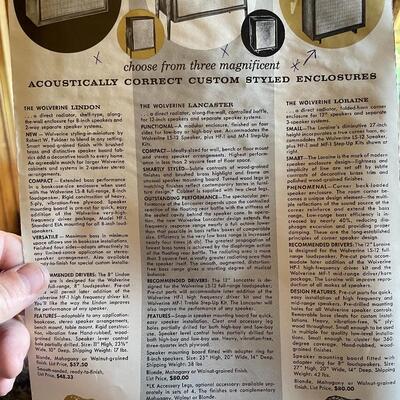
Please note: Additional pictures added on Aug 2nd. The family remembers this jewel playing Flip Wilson, Disney Story albums, ABBA, Olivia Newton John, Bing Crosby Christmas throughout their childhoods in the late 50's, 60's and 70's.... then a family member brought back the latest and greatest of the day after a trip to Korea. Probably has been unplugged ever since then. The unit is untested, but was said to be in fine working condition until the modern day replacement arrived in 1982. (They still have that one, too!) Buyer to pay shipping and handling. Local pickup available. 138 / 591 -
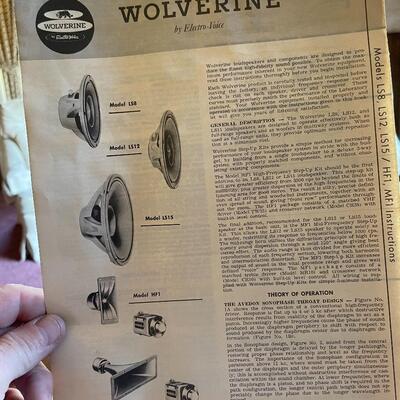
Please note: Additional pictures added on Aug 2nd. The family remembers this jewel playing Flip Wilson, Disney Story albums, ABBA, Olivia Newton John, Bing Crosby Christmas throughout their childhoods in the late 50's, 60's and 70's.... then a family member brought back the latest and greatest of the day after a trip to Korea. Probably has been unplugged ever since then. The unit is untested, but was said to be in fine working condition until the modern day replacement arrived in 1982. (They still have that one, too!) Buyer to pay shipping and handling. Local pickup available. 139 / 591 -
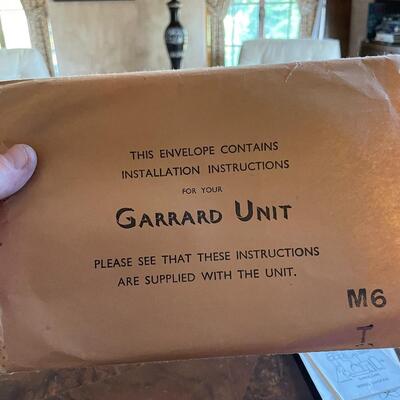
Please note: Additional pictures added on Aug 2nd. The family remembers this jewel playing Flip Wilson, Disney Story albums, ABBA, Olivia Newton John, Bing Crosby Christmas throughout their childhoods in the late 50's, 60's and 70's.... then a family member brought back the latest and greatest of the day after a trip to Korea. Probably has been unplugged ever since then. The unit is untested, but was said to be in fine working condition until the modern day replacement arrived in 1982. (They still have that one, too!) Buyer to pay shipping and handling. Local pickup available. 140 / 591 -

Please note: Additional pictures added on Aug 2nd. The family remembers this jewel playing Flip Wilson, Disney Story albums, ABBA, Olivia Newton John, Bing Crosby Christmas throughout their childhoods in the late 50's, 60's and 70's.... then a family member brought back the latest and greatest of the day after a trip to Korea. Probably has been unplugged ever since then. The unit is untested, but was said to be in fine working condition until the modern day replacement arrived in 1982. (They still have that one, too!) Buyer to pay shipping and handling. Local pickup available. 141 / 591 -

Please note: Additional pictures added on Aug 2nd. The family remembers this jewel playing Flip Wilson, Disney Story albums, ABBA, Olivia Newton John, Bing Crosby Christmas throughout their childhoods in the late 50's, 60's and 70's.... then a family member brought back the latest and greatest of the day after a trip to Korea. Probably has been unplugged ever since then. The unit is untested, but was said to be in fine working condition until the modern day replacement arrived in 1982. (They still have that one, too!) Buyer to pay shipping and handling. Local pickup available. 142 / 591 -
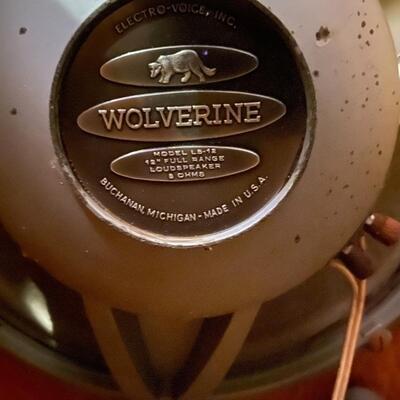
Please note: Additional pictures added on Aug 2nd. The family remembers this jewel playing Flip Wilson, Disney Story albums, ABBA, Olivia Newton John, Bing Crosby Christmas throughout their childhoods in the late 50's, 60's and 70's.... then a family member brought back the latest and greatest of the day after a trip to Korea. Probably has been unplugged ever since then. The unit is untested, but was said to be in fine working condition until the modern day replacement arrived in 1982. (They still have that one, too!) Buyer to pay shipping and handling. Local pickup available. 143 / 591 -
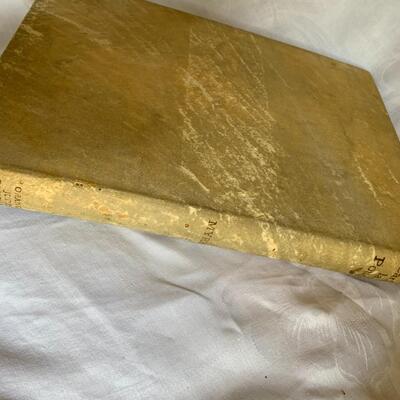
This is a 1905 Cache la Poudre – The Romance of a Tenderfoot in the Days of Custer first edition and limited edition (292 of 500 copies) book by Herbert Myrick. The book includes illustrations from paintings by Charles Schreyvogel, Edward W. Deming, and Henry Fangel. It is bound in Indian smoke tanned buckskin. While the cover has lost most of its fringe, the book is in good condition. The pages are very good condition with no writing but a few of the attached arts shows minor folds at the base of the photo. Please see photos to determine condition. Only 500 on the planet. 144 / 591 -
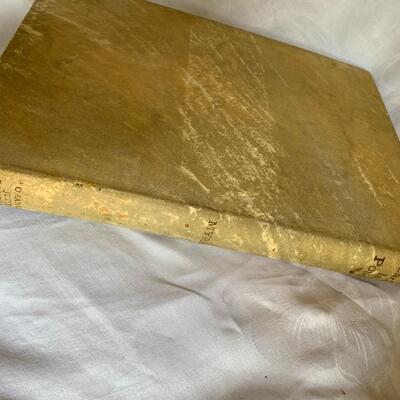
This is a 1905 Cache la Poudre – The Romance of a Tenderfoot in the Days of Custer first edition and limited edition (292 of 500 copies) book by Herbert Myrick. The book includes illustrations from paintings by Charles Schreyvogel, Edward W. Deming, and Henry Fangel. It is bound in Indian smoke tanned buckskin. While the cover has lost most of its fringe, the book is in good condition. The pages are very good condition with no writing but a few of the attached arts shows minor folds at the base of the photo. Please see photos to determine condition. Only 500 on the planet. 145 / 591 -
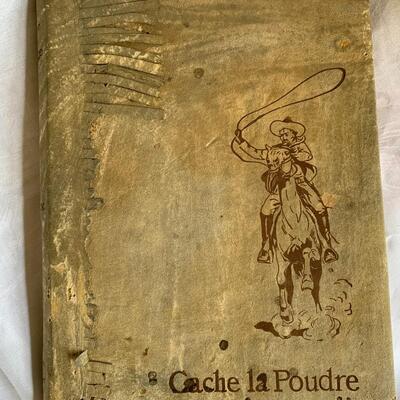
This is a 1905 Cache la Poudre – The Romance of a Tenderfoot in the Days of Custer first edition and limited edition (292 of 500 copies) book by Herbert Myrick. The book includes illustrations from paintings by Charles Schreyvogel, Edward W. Deming, and Henry Fangel. It is bound in Indian smoke tanned buckskin. While the cover has lost most of its fringe, the book is in good condition. The pages are very good condition with no writing but a few of the attached arts shows minor folds at the base of the photo. Please see photos to determine condition. Only 500 on the planet. 146 / 591 -
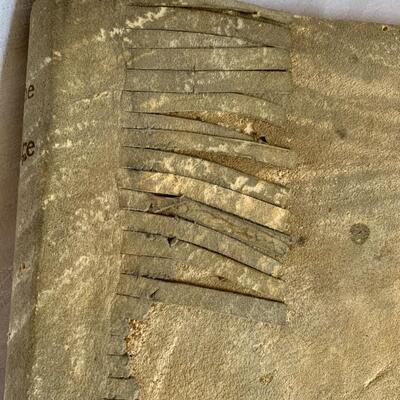
This is a 1905 Cache la Poudre – The Romance of a Tenderfoot in the Days of Custer first edition and limited edition (292 of 500 copies) book by Herbert Myrick. The book includes illustrations from paintings by Charles Schreyvogel, Edward W. Deming, and Henry Fangel. It is bound in Indian smoke tanned buckskin. While the cover has lost most of its fringe, the book is in good condition. The pages are very good condition with no writing but a few of the attached arts shows minor folds at the base of the photo. Please see photos to determine condition. Only 500 on the planet. 147 / 591 -
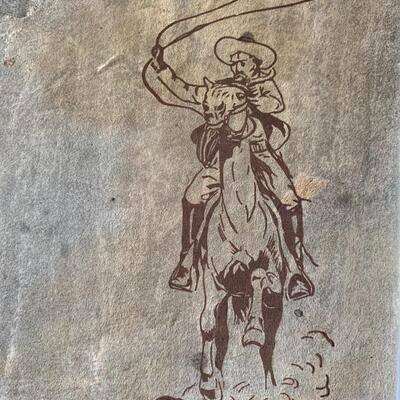
This is a 1905 Cache la Poudre – The Romance of a Tenderfoot in the Days of Custer first edition and limited edition (292 of 500 copies) book by Herbert Myrick. The book includes illustrations from paintings by Charles Schreyvogel, Edward W. Deming, and Henry Fangel. It is bound in Indian smoke tanned buckskin. While the cover has lost most of its fringe, the book is in good condition. The pages are very good condition with no writing but a few of the attached arts shows minor folds at the base of the photo. Please see photos to determine condition. Only 500 on the planet. 148 / 591 -
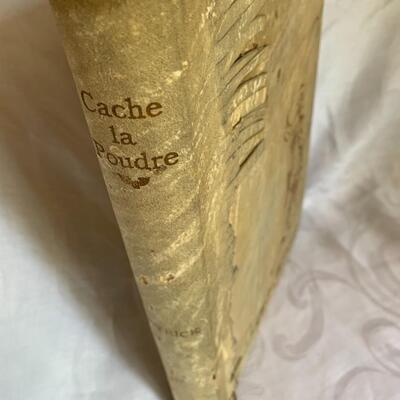
This is a 1905 Cache la Poudre – The Romance of a Tenderfoot in the Days of Custer first edition and limited edition (292 of 500 copies) book by Herbert Myrick. The book includes illustrations from paintings by Charles Schreyvogel, Edward W. Deming, and Henry Fangel. It is bound in Indian smoke tanned buckskin. While the cover has lost most of its fringe, the book is in good condition. The pages are very good condition with no writing but a few of the attached arts shows minor folds at the base of the photo. Please see photos to determine condition. Only 500 on the planet. 149 / 591 -
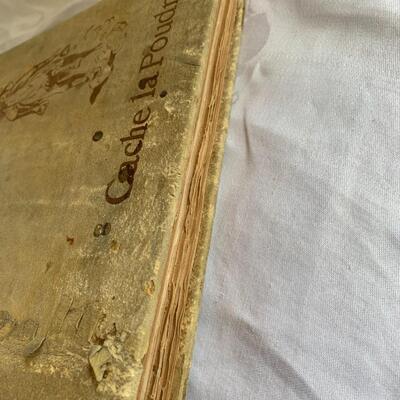
This is a 1905 Cache la Poudre – The Romance of a Tenderfoot in the Days of Custer first edition and limited edition (292 of 500 copies) book by Herbert Myrick. The book includes illustrations from paintings by Charles Schreyvogel, Edward W. Deming, and Henry Fangel. It is bound in Indian smoke tanned buckskin. While the cover has lost most of its fringe, the book is in good condition. The pages are very good condition with no writing but a few of the attached arts shows minor folds at the base of the photo. Please see photos to determine condition. Only 500 on the planet. 150 / 591 -
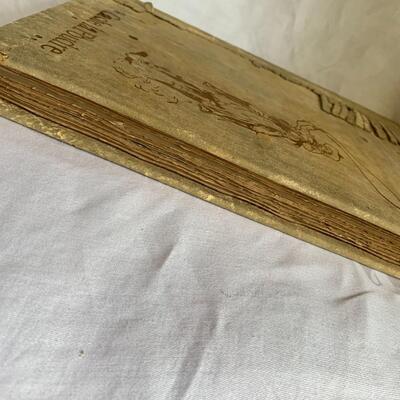
This is a 1905 Cache la Poudre – The Romance of a Tenderfoot in the Days of Custer first edition and limited edition (292 of 500 copies) book by Herbert Myrick. The book includes illustrations from paintings by Charles Schreyvogel, Edward W. Deming, and Henry Fangel. It is bound in Indian smoke tanned buckskin. While the cover has lost most of its fringe, the book is in good condition. The pages are very good condition with no writing but a few of the attached arts shows minor folds at the base of the photo. Please see photos to determine condition. Only 500 on the planet. 151 / 591 -
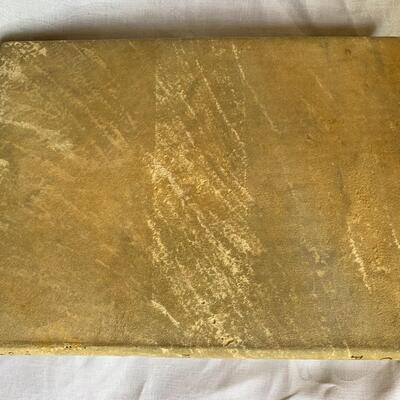
This is a 1905 Cache la Poudre – The Romance of a Tenderfoot in the Days of Custer first edition and limited edition (292 of 500 copies) book by Herbert Myrick. The book includes illustrations from paintings by Charles Schreyvogel, Edward W. Deming, and Henry Fangel. It is bound in Indian smoke tanned buckskin. While the cover has lost most of its fringe, the book is in good condition. The pages are very good condition with no writing but a few of the attached arts shows minor folds at the base of the photo. Please see photos to determine condition. Only 500 on the planet. 152 / 591 -
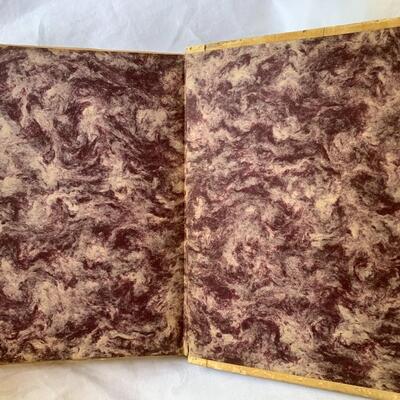
This is a 1905 Cache la Poudre – The Romance of a Tenderfoot in the Days of Custer first edition and limited edition (292 of 500 copies) book by Herbert Myrick. The book includes illustrations from paintings by Charles Schreyvogel, Edward W. Deming, and Henry Fangel. It is bound in Indian smoke tanned buckskin. While the cover has lost most of its fringe, the book is in good condition. The pages are very good condition with no writing but a few of the attached arts shows minor folds at the base of the photo. Please see photos to determine condition. Only 500 on the planet. 153 / 591 -
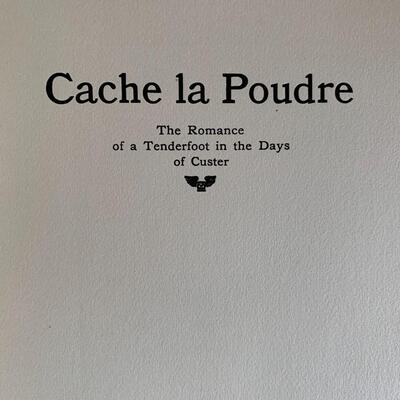
This is a 1905 Cache la Poudre – The Romance of a Tenderfoot in the Days of Custer first edition and limited edition (292 of 500 copies) book by Herbert Myrick. The book includes illustrations from paintings by Charles Schreyvogel, Edward W. Deming, and Henry Fangel. It is bound in Indian smoke tanned buckskin. While the cover has lost most of its fringe, the book is in good condition. The pages are very good condition with no writing but a few of the attached arts shows minor folds at the base of the photo. Please see photos to determine condition. Only 500 on the planet. 154 / 591 -
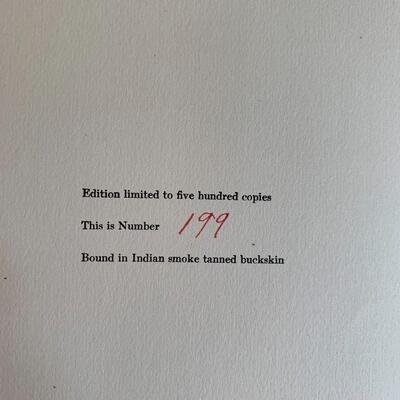
This is a 1905 Cache la Poudre – The Romance of a Tenderfoot in the Days of Custer first edition and limited edition (292 of 500 copies) book by Herbert Myrick. The book includes illustrations from paintings by Charles Schreyvogel, Edward W. Deming, and Henry Fangel. It is bound in Indian smoke tanned buckskin. While the cover has lost most of its fringe, the book is in good condition. The pages are very good condition with no writing but a few of the attached arts shows minor folds at the base of the photo. Please see photos to determine condition. Only 500 on the planet. 155 / 591 -

This is a 1905 Cache la Poudre – The Romance of a Tenderfoot in the Days of Custer first edition and limited edition (292 of 500 copies) book by Herbert Myrick. The book includes illustrations from paintings by Charles Schreyvogel, Edward W. Deming, and Henry Fangel. It is bound in Indian smoke tanned buckskin. While the cover has lost most of its fringe, the book is in good condition. The pages are very good condition with no writing but a few of the attached arts shows minor folds at the base of the photo. Please see photos to determine condition. Only 500 on the planet. 156 / 591 -
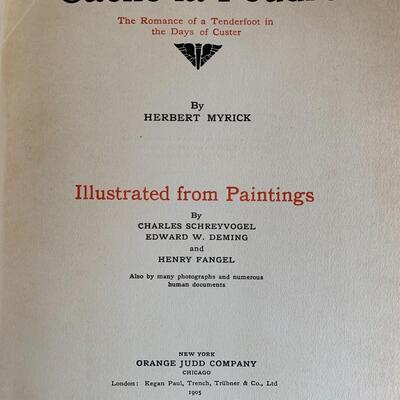
This is a 1905 Cache la Poudre – The Romance of a Tenderfoot in the Days of Custer first edition and limited edition (292 of 500 copies) book by Herbert Myrick. The book includes illustrations from paintings by Charles Schreyvogel, Edward W. Deming, and Henry Fangel. It is bound in Indian smoke tanned buckskin. While the cover has lost most of its fringe, the book is in good condition. The pages are very good condition with no writing but a few of the attached arts shows minor folds at the base of the photo. Please see photos to determine condition. Only 500 on the planet. 157 / 591 -
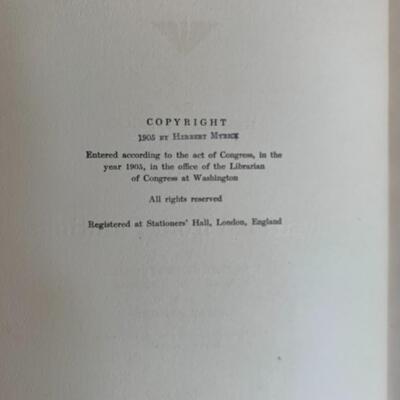
This is a 1905 Cache la Poudre – The Romance of a Tenderfoot in the Days of Custer first edition and limited edition (292 of 500 copies) book by Herbert Myrick. The book includes illustrations from paintings by Charles Schreyvogel, Edward W. Deming, and Henry Fangel. It is bound in Indian smoke tanned buckskin. While the cover has lost most of its fringe, the book is in good condition. The pages are very good condition with no writing but a few of the attached arts shows minor folds at the base of the photo. Please see photos to determine condition. Only 500 on the planet. 158 / 591 -
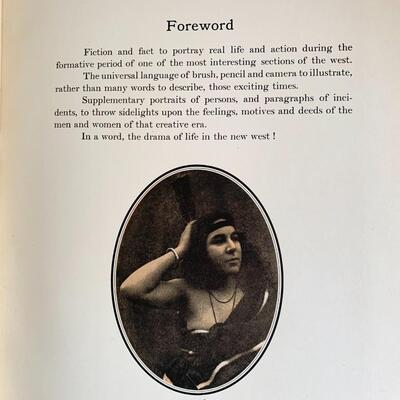
This is a 1905 Cache la Poudre – The Romance of a Tenderfoot in the Days of Custer first edition and limited edition (292 of 500 copies) book by Herbert Myrick. The book includes illustrations from paintings by Charles Schreyvogel, Edward W. Deming, and Henry Fangel. It is bound in Indian smoke tanned buckskin. While the cover has lost most of its fringe, the book is in good condition. The pages are very good condition with no writing but a few of the attached arts shows minor folds at the base of the photo. Please see photos to determine condition. Only 500 on the planet. 159 / 591 -
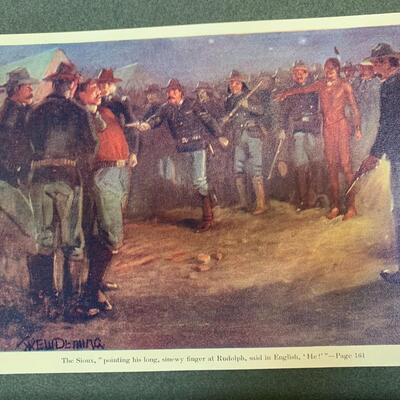
This is a 1905 Cache la Poudre – The Romance of a Tenderfoot in the Days of Custer first edition and limited edition (292 of 500 copies) book by Herbert Myrick. The book includes illustrations from paintings by Charles Schreyvogel, Edward W. Deming, and Henry Fangel. It is bound in Indian smoke tanned buckskin. While the cover has lost most of its fringe, the book is in good condition. The pages are very good condition with no writing but a few of the attached arts shows minor folds at the base of the photo. Please see photos to determine condition. Only 500 on the planet. 160 / 591 -
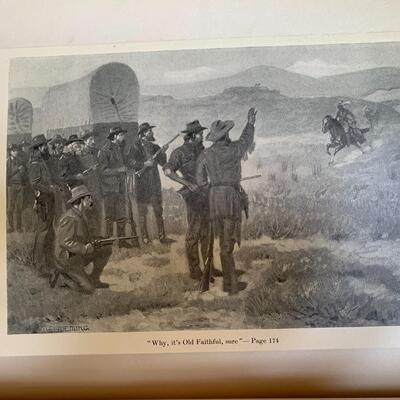
This is a 1905 Cache la Poudre – The Romance of a Tenderfoot in the Days of Custer first edition and limited edition (292 of 500 copies) book by Herbert Myrick. The book includes illustrations from paintings by Charles Schreyvogel, Edward W. Deming, and Henry Fangel. It is bound in Indian smoke tanned buckskin. While the cover has lost most of its fringe, the book is in good condition. The pages are very good condition with no writing but a few of the attached arts shows minor folds at the base of the photo. Please see photos to determine condition. Only 500 on the planet. 161 / 591 -
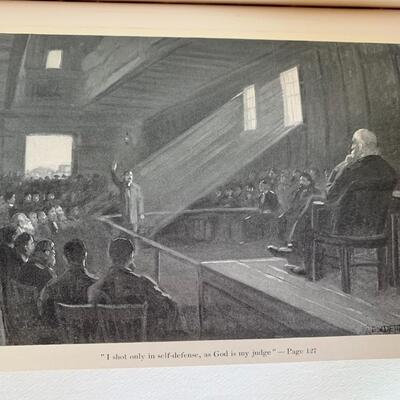
This is a 1905 Cache la Poudre – The Romance of a Tenderfoot in the Days of Custer first edition and limited edition (292 of 500 copies) book by Herbert Myrick. The book includes illustrations from paintings by Charles Schreyvogel, Edward W. Deming, and Henry Fangel. It is bound in Indian smoke tanned buckskin. While the cover has lost most of its fringe, the book is in good condition. The pages are very good condition with no writing but a few of the attached arts shows minor folds at the base of the photo. Please see photos to determine condition. Only 500 on the planet. 162 / 591 -
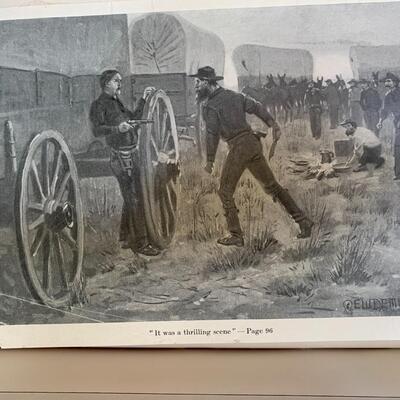
This is a 1905 Cache la Poudre – The Romance of a Tenderfoot in the Days of Custer first edition and limited edition (292 of 500 copies) book by Herbert Myrick. The book includes illustrations from paintings by Charles Schreyvogel, Edward W. Deming, and Henry Fangel. It is bound in Indian smoke tanned buckskin. While the cover has lost most of its fringe, the book is in good condition. The pages are very good condition with no writing but a few of the attached arts shows minor folds at the base of the photo. Please see photos to determine condition. Only 500 on the planet. 163 / 591 -
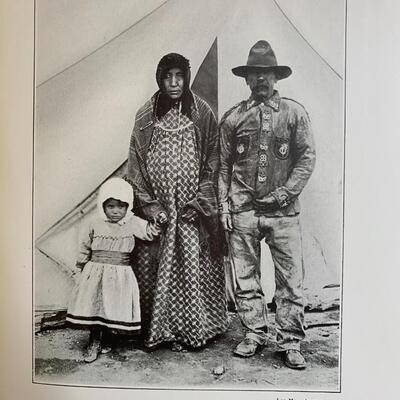
This is a 1905 Cache la Poudre – The Romance of a Tenderfoot in the Days of Custer first edition and limited edition (292 of 500 copies) book by Herbert Myrick. The book includes illustrations from paintings by Charles Schreyvogel, Edward W. Deming, and Henry Fangel. It is bound in Indian smoke tanned buckskin. While the cover has lost most of its fringe, the book is in good condition. The pages are very good condition with no writing but a few of the attached arts shows minor folds at the base of the photo. Please see photos to determine condition. Only 500 on the planet. 164 / 591 -
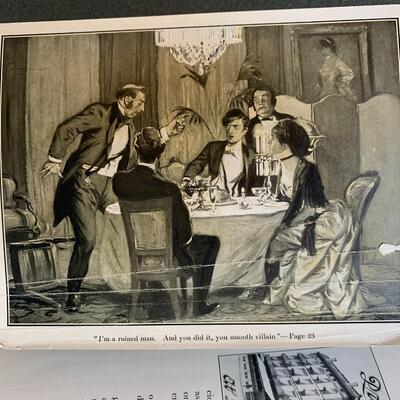
This is a 1905 Cache la Poudre – The Romance of a Tenderfoot in the Days of Custer first edition and limited edition (292 of 500 copies) book by Herbert Myrick. The book includes illustrations from paintings by Charles Schreyvogel, Edward W. Deming, and Henry Fangel. It is bound in Indian smoke tanned buckskin. While the cover has lost most of its fringe, the book is in good condition. The pages are very good condition with no writing but a few of the attached arts shows minor folds at the base of the photo. Please see photos to determine condition. Only 500 on the planet. 165 / 591 -
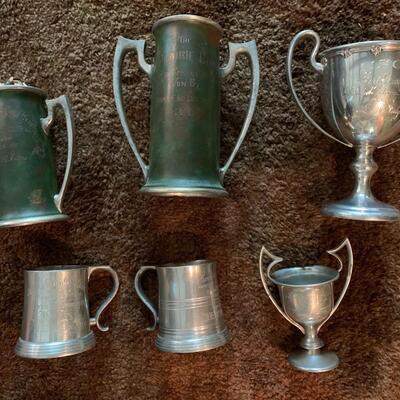
Famed as being one of the first 3 golf courses of its kind in the United States (circa 1897), The Town and Gown Golf Course (later renamed the Colorado Springs Golf Club), has these trophies to reveal its TRUE history! Found in an attic in Edmond, OK is the true beginnings of what is now known as the Patty Jewett Golf Course of Colorado Springs, CO. Read the obituary (pictured) Pictures of the obituaries and McIntyre men of three generations added to photos for historic interest. 166 / 591 sold -

Famed as being one of the first 3 golf courses of its kind in the United States (circa 1897), The Town and Gown Golf Course (later renamed the Colorado Springs Golf Club), has these trophies to reveal its TRUE history! Found in an attic in Edmond, OK is the true beginnings of what is now known as the Patty Jewett Golf Course of Colorado Springs, CO. Read the obituary (pictured) Pictures of the obituaries and McIntyre men of three generations added to photos for historic interest. 167 / 591 sold -
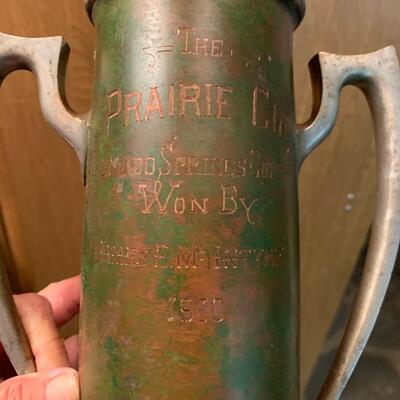
Famed as being one of the first 3 golf courses of its kind in the United States (circa 1897), The Town and Gown Golf Course (later renamed the Colorado Springs Golf Club), has these trophies to reveal its TRUE history! Found in an attic in Edmond, OK is the true beginnings of what is now known as the Patty Jewett Golf Course of Colorado Springs, CO. Read the obituary (pictured) Pictures of the obituaries and McIntyre men of three generations added to photos for historic interest. 168 / 591 sold -
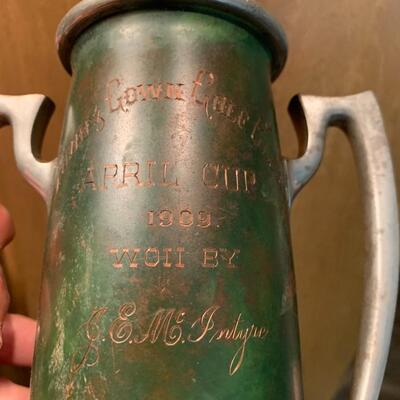
Famed as being one of the first 3 golf courses of its kind in the United States (circa 1897), The Town and Gown Golf Course (later renamed the Colorado Springs Golf Club), has these trophies to reveal its TRUE history! Found in an attic in Edmond, OK is the true beginnings of what is now known as the Patty Jewett Golf Course of Colorado Springs, CO. Read the obituary (pictured) Pictures of the obituaries and McIntyre men of three generations added to photos for historic interest. 169 / 591 sold -
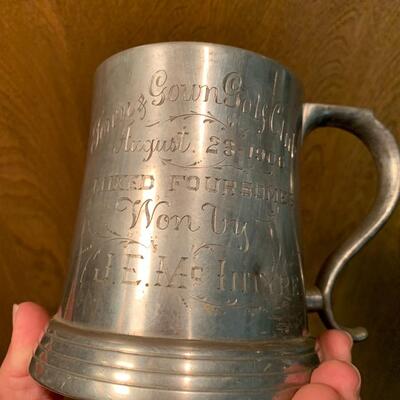
Famed as being one of the first 3 golf courses of its kind in the United States (circa 1897), The Town and Gown Golf Course (later renamed the Colorado Springs Golf Club), has these trophies to reveal its TRUE history! Found in an attic in Edmond, OK is the true beginnings of what is now known as the Patty Jewett Golf Course of Colorado Springs, CO. Read the obituary (pictured) Pictures of the obituaries and McIntyre men of three generations added to photos for historic interest. 170 / 591 sold -
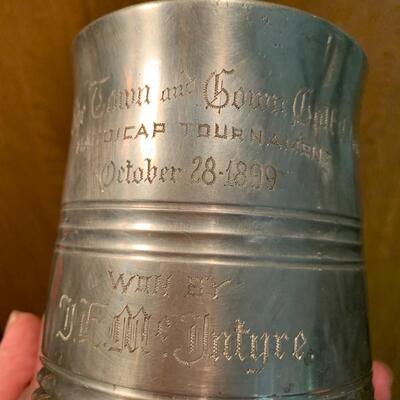
Famed as being one of the first 3 golf courses of its kind in the United States (circa 1897), The Town and Gown Golf Course (later renamed the Colorado Springs Golf Club), has these trophies to reveal its TRUE history! Found in an attic in Edmond, OK is the true beginnings of what is now known as the Patty Jewett Golf Course of Colorado Springs, CO. Read the obituary (pictured) Pictures of the obituaries and McIntyre men of three generations added to photos for historic interest. 171 / 591 sold -
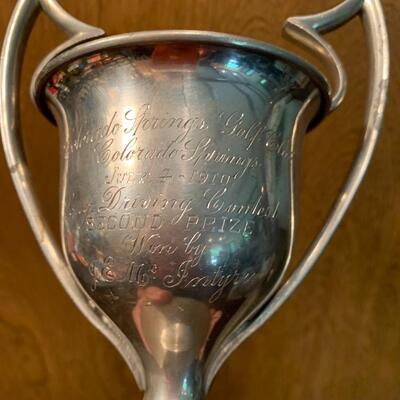
Famed as being one of the first 3 golf courses of its kind in the United States (circa 1897), The Town and Gown Golf Course (later renamed the Colorado Springs Golf Club), has these trophies to reveal its TRUE history! Found in an attic in Edmond, OK is the true beginnings of what is now known as the Patty Jewett Golf Course of Colorado Springs, CO. Read the obituary (pictured) Pictures of the obituaries and McIntyre men of three generations added to photos for historic interest. 172 / 591 sold -
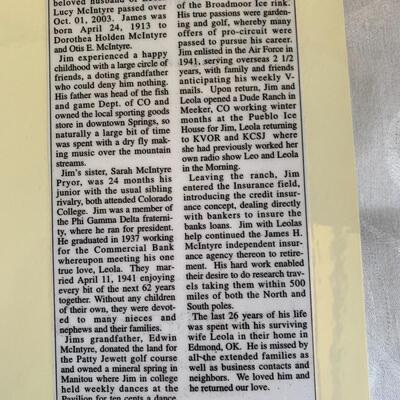
Famed as being one of the first 3 golf courses of its kind in the United States (circa 1897), The Town and Gown Golf Course (later renamed the Colorado Springs Golf Club), has these trophies to reveal its TRUE history! Found in an attic in Edmond, OK is the true beginnings of what is now known as the Patty Jewett Golf Course of Colorado Springs, CO. Read the obituary (pictured) Pictures of the obituaries and McIntyre men of three generations added to photos for historic interest. 173 / 591 sold -

Famed as being one of the first 3 golf courses of its kind in the United States (circa 1897), The Town and Gown Golf Course (later renamed the Colorado Springs Golf Club), has these trophies to reveal its TRUE history! Found in an attic in Edmond, OK is the true beginnings of what is now known as the Patty Jewett Golf Course of Colorado Springs, CO. Read the obituary (pictured) Pictures of the obituaries and McIntyre men of three generations added to photos for historic interest. 174 / 591 sold -
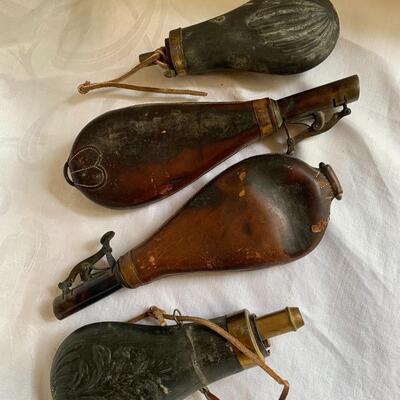
ANTIQUE CIVIL WAR ERA BRASS & LEATHER MUZZLE SHOT LOADER POUCH FLASK. An authentic antique Civil War era leather shot flask / pouch with brass stopper. One of the leather pouches is about 40-50% full musket shot, providing a nice heft to this collectible piece of US history. Items are in very fine condition considering their age as an antique relic. Top closes securely on both leather flasks. The leather is still pliable and there are not holes.The brass flasks are open and do not have caps. Please see photos for more details and to determine the condition of these items. 175 / 591 -
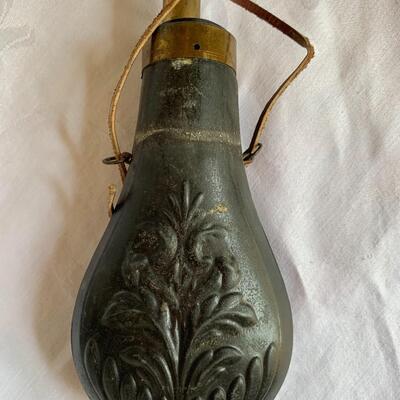
ANTIQUE CIVIL WAR ERA BRASS & LEATHER MUZZLE SHOT LOADER POUCH FLASK. An authentic antique Civil War era leather shot flask / pouch with brass stopper. One of the leather pouches is about 40-50% full musket shot, providing a nice heft to this collectible piece of US history. Items are in very fine condition considering their age as an antique relic. Top closes securely on both leather flasks. The leather is still pliable and there are not holes.The brass flasks are open and do not have caps. Please see photos for more details and to determine the condition of these items. 176 / 591 -
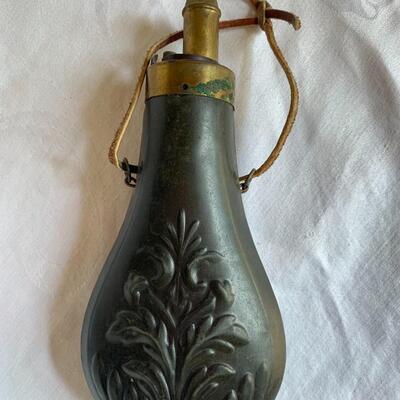
ANTIQUE CIVIL WAR ERA BRASS & LEATHER MUZZLE SHOT LOADER POUCH FLASK. An authentic antique Civil War era leather shot flask / pouch with brass stopper. One of the leather pouches is about 40-50% full musket shot, providing a nice heft to this collectible piece of US history. Items are in very fine condition considering their age as an antique relic. Top closes securely on both leather flasks. The leather is still pliable and there are not holes.The brass flasks are open and do not have caps. Please see photos for more details and to determine the condition of these items. 177 / 591 -

ANTIQUE CIVIL WAR ERA BRASS & LEATHER MUZZLE SHOT LOADER POUCH FLASK. An authentic antique Civil War era leather shot flask / pouch with brass stopper. One of the leather pouches is about 40-50% full musket shot, providing a nice heft to this collectible piece of US history. Items are in very fine condition considering their age as an antique relic. Top closes securely on both leather flasks. The leather is still pliable and there are not holes.The brass flasks are open and do not have caps. Please see photos for more details and to determine the condition of these items. 178 / 591 -
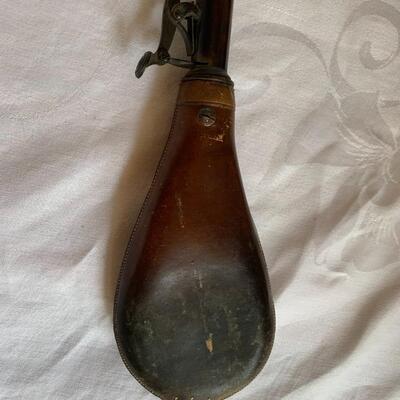
ANTIQUE CIVIL WAR ERA BRASS & LEATHER MUZZLE SHOT LOADER POUCH FLASK. An authentic antique Civil War era leather shot flask / pouch with brass stopper. One of the leather pouches is about 40-50% full musket shot, providing a nice heft to this collectible piece of US history. Items are in very fine condition considering their age as an antique relic. Top closes securely on both leather flasks. The leather is still pliable and there are not holes.The brass flasks are open and do not have caps. Please see photos for more details and to determine the condition of these items. 179 / 591 -
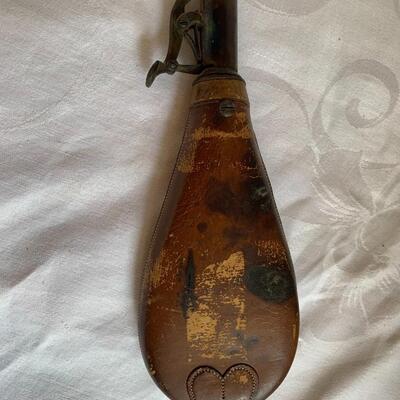
ANTIQUE CIVIL WAR ERA BRASS & LEATHER MUZZLE SHOT LOADER POUCH FLASK. An authentic antique Civil War era leather shot flask / pouch with brass stopper. One of the leather pouches is about 40-50% full musket shot, providing a nice heft to this collectible piece of US history. Items are in very fine condition considering their age as an antique relic. Top closes securely on both leather flasks. The leather is still pliable and there are not holes.The brass flasks are open and do not have caps. Please see photos for more details and to determine the condition of these items. 180 / 591 -
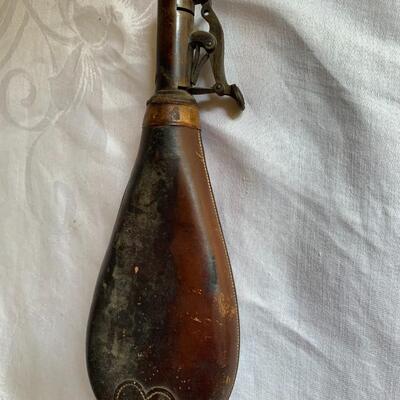
ANTIQUE CIVIL WAR ERA BRASS & LEATHER MUZZLE SHOT LOADER POUCH FLASK. An authentic antique Civil War era leather shot flask / pouch with brass stopper. One of the leather pouches is about 40-50% full musket shot, providing a nice heft to this collectible piece of US history. Items are in very fine condition considering their age as an antique relic. Top closes securely on both leather flasks. The leather is still pliable and there are not holes.The brass flasks are open and do not have caps. Please see photos for more details and to determine the condition of these items. 181 / 591 -

ANTIQUE CIVIL WAR ERA BRASS & LEATHER MUZZLE SHOT LOADER POUCH FLASK. An authentic antique Civil War era leather shot flask / pouch with brass stopper. One of the leather pouches is about 40-50% full musket shot, providing a nice heft to this collectible piece of US history. Items are in very fine condition considering their age as an antique relic. Top closes securely on both leather flasks. The leather is still pliable and there are not holes.The brass flasks are open and do not have caps. Please see photos for more details and to determine the condition of these items. 182 / 591 -
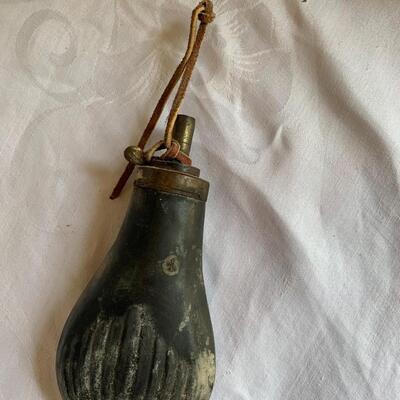
ANTIQUE CIVIL WAR ERA BRASS & LEATHER MUZZLE SHOT LOADER POUCH FLASK. An authentic antique Civil War era leather shot flask / pouch with brass stopper. One of the leather pouches is about 40-50% full musket shot, providing a nice heft to this collectible piece of US history. Items are in very fine condition considering their age as an antique relic. Top closes securely on both leather flasks. The leather is still pliable and there are not holes.The brass flasks are open and do not have caps. Please see photos for more details and to determine the condition of these items. 183 / 591 -

An exceptional painting by Mary Creamer! Scroll down to read bio. \/ Canvas Measures: 19 1/4" wide x 16" height Frame Measures: 22 1/4" wide x 20 3/4" height American artist Mary Creamer, active ca. 1925 - 1975, was a teacher and painter of portraiture, the figure, still-life and landscape in both oil and watercolor. Absent any birth, census (pre-1940), marriage, or death records in this name, Creamer's biographical details remained almost wholly hidden, and details of her artistic career not pursued, until the recent September 2011 location of a painting signed "Mary Creamer" with an original label verso bearing her un-wed sister's name.(1) Mary Creamer was born Edna Pearl King to James Robert King and Leona L. (Weldon) King in Hart Co, KY on 23 April 1892. (2) Her seamstress mother, Leona, by 1910 twice divorced and single, had moved with her two daughters Edna "Mary" and Bernice, from Kentucky to Indiana. In that year (1910), Mary, age 17, was boarding with Indiana friends living in St. Louis MO. It was evidently there where she met the Missouri native Charles P. Creamer; they were married on 14 April 1914. (3) The youthful Creamer took her earliest instruction in art in St. Louis, at Washington University; but it was sometime after 1920, following relocation to Oklahoma City, that during a lengthy hospital stay - when medical wisdom predicted a virtual certainty of losing her eyesight and perhaps her life - that Creamer was sustained by a commitment to becoming an artist, and immediately upon release entered the School of Art at the University of Oklahoma (Norman).(4) Creamer's Church in the Oil Fields, painted in her first semester there, took a second prize in a state show; impressed by the young artist's talent, instructor Genoa Morris (5) arranged for a local exhibition of Creamer's work, at which eighteen paintings immediately sold [LAJ]. From her home in Oklahoma City Creamer would frequently thereafter travel to study, paint and exhibit both in the east and in the west. Early on, in the East, she worked with Margaret Fitzhugh Browne (1887-1972) in Boston: from her Creamer was doubtless able to develop her facility in figure-painting, as well as the floral still-life, in both of which Browne excelled. In addition to time in Gloucester and Springfield Massachusetts, Creamer also took instruction with the noted watercolorist, instructor and author Eliot O'Hara ([1890-1969] likely in New York but possibly Maine). By the mid-1930s Creamer had - on the evidence, typically over summers - begun painting trips in the other direction, first in Taos NM, and soon thereafter in Santa Fe.(6) The call of the Southwest would eventually find Mary Creamer and her husband moving to southern California, sometime after 1941. From there the painterly environs of Nevada, Arizona and New Mexico were relatively accessible; but there, too, in Los Angeles and especially Taos, did Creamer find a supportive and growing community of artists and teachers. Among the latter was William Frederick Foster (1883-1953), a native mid-westerner who studied first with Frank Duveneck in Cincinnati and then with Robert Henri and William Merritt Chase in New York. Foster worked primarily as an illustrator until 1930, and Creamer is likely to have known him from her earlier trips in NY: one is invited to wonder if Foster's influence as an illustrator, joined to the figure training with Browne, was influential in Mary Creamer's execution of In the Land of Nod, said to have "later won no fewer than eight awards in two years, four of them juried in New York." (7) Having moved to Los Angeles in 1932, Foster taught at the Chouinard School of Art and also gave private classes in his own studio: it is presumably there that Creamer took further training from him. Both were active members of the California Arts Association (Los Angeles), as was the younger artist and teacher Nell Walker Warner (1891-1970). Creamer doubtless knew Warner during the latter's years as a young teacher in the Los Angeles area, and perhaps also from their common interests harbor scenes: both had traveled widely, including to Europe but also visiting Gloucester to paint, and when Warner moved north to the ocean-side art colony of Carmel CA in 1952, Creamer spent time with her there.(8) Mary Creamer lived in Dana Point (near Laguna Beach), San Diego, and Banning, but by mid-60s was traveling with enough regularity to paint, exhibit and teach in Arizona, Nevada, and New Mexico that in 1964 she and her husband established a second "permanent residence at her Taos home" [TN1] that summer. It was near this time, "by way of rounding out her ability as a portrait artist," that she learned from the noted painter Henry Balink (1882-1963) in Santa Fe how to "render the flesh tones and physical forms" of native American Indians: her canvas entitled My Son is reported [LAJ] to have won many awards and "prompted the Taos masters to request the same models, [and] the same pose too." In summers she taught classes at Taos, Carson City, and Reno, exhibiting her traditional representational art - portraits, landscapes and still-life - at the Nevada Art Gallery / State Museum in Reno and at smaller galleries there (the Blue Door, Carson Furniture Gallery, the Village Gallery, etc.). (9) In shows, Mary Creamer had as of 1965 won 18 first prizes, 16 second awards, 15 honorable mentions, four purchase awards, three sweepstakes, and others. In 1967 she taught at South Plains College in Levelland TX [LAJ]. Thereafter she was an active participant in the California Art Club, remaining a member through 1979: in the November 1974 CAC show at their Westwood Galleries, she exhibited Window in the Sky, California Landscape, Hawaiian Inlet, and Morning in the Desert. Though sometimes rendering canvases in the impressionist style (see for example her excellent African Violet), Creamer was committed to traditional realist representations of her subjects - this, she said, "because I like God's ideas as they are. No one, anywhere, can improve on nature, and the human body is the highest expression of creation" [LAJ]. Mary Creamer was a member of the National Association of Women Artists (NY), Pen and Brush (NY), the National League of American Pen Women (Washington D.C.), the Springfield Art Association, the Springfield Art League (Springfield MA), the California Arts Club (Los Angeles), American Institute of Fine Arts (Los Angeles), San Diego Art Association, and the Desert Art Center (Palm Springs CA). She was listed in the '60s editions of Who's Who in the Midwest and Who's Who of American Women [TN1]. 184 / 591 -
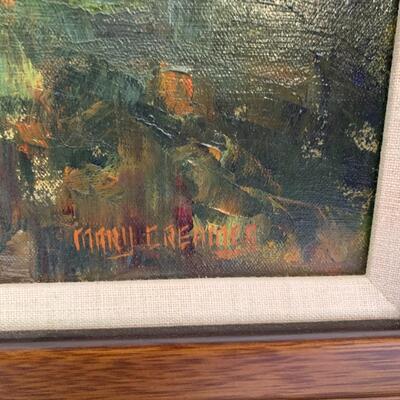
An exceptional painting by Mary Creamer! Scroll down to read bio. \/ Canvas Measures: 19 1/4" wide x 16" height Frame Measures: 22 1/4" wide x 20 3/4" height American artist Mary Creamer, active ca. 1925 - 1975, was a teacher and painter of portraiture, the figure, still-life and landscape in both oil and watercolor. Absent any birth, census (pre-1940), marriage, or death records in this name, Creamer's biographical details remained almost wholly hidden, and details of her artistic career not pursued, until the recent September 2011 location of a painting signed "Mary Creamer" with an original label verso bearing her un-wed sister's name.(1) Mary Creamer was born Edna Pearl King to James Robert King and Leona L. (Weldon) King in Hart Co, KY on 23 April 1892. (2) Her seamstress mother, Leona, by 1910 twice divorced and single, had moved with her two daughters Edna "Mary" and Bernice, from Kentucky to Indiana. In that year (1910), Mary, age 17, was boarding with Indiana friends living in St. Louis MO. It was evidently there where she met the Missouri native Charles P. Creamer; they were married on 14 April 1914. (3) The youthful Creamer took her earliest instruction in art in St. Louis, at Washington University; but it was sometime after 1920, following relocation to Oklahoma City, that during a lengthy hospital stay - when medical wisdom predicted a virtual certainty of losing her eyesight and perhaps her life - that Creamer was sustained by a commitment to becoming an artist, and immediately upon release entered the School of Art at the University of Oklahoma (Norman).(4) Creamer's Church in the Oil Fields, painted in her first semester there, took a second prize in a state show; impressed by the young artist's talent, instructor Genoa Morris (5) arranged for a local exhibition of Creamer's work, at which eighteen paintings immediately sold [LAJ]. From her home in Oklahoma City Creamer would frequently thereafter travel to study, paint and exhibit both in the east and in the west. Early on, in the East, she worked with Margaret Fitzhugh Browne (1887-1972) in Boston: from her Creamer was doubtless able to develop her facility in figure-painting, as well as the floral still-life, in both of which Browne excelled. In addition to time in Gloucester and Springfield Massachusetts, Creamer also took instruction with the noted watercolorist, instructor and author Eliot O'Hara ([1890-1969] likely in New York but possibly Maine). By the mid-1930s Creamer had - on the evidence, typically over summers - begun painting trips in the other direction, first in Taos NM, and soon thereafter in Santa Fe.(6) The call of the Southwest would eventually find Mary Creamer and her husband moving to southern California, sometime after 1941. From there the painterly environs of Nevada, Arizona and New Mexico were relatively accessible; but there, too, in Los Angeles and especially Taos, did Creamer find a supportive and growing community of artists and teachers. Among the latter was William Frederick Foster (1883-1953), a native mid-westerner who studied first with Frank Duveneck in Cincinnati and then with Robert Henri and William Merritt Chase in New York. Foster worked primarily as an illustrator until 1930, and Creamer is likely to have known him from her earlier trips in NY: one is invited to wonder if Foster's influence as an illustrator, joined to the figure training with Browne, was influential in Mary Creamer's execution of In the Land of Nod, said to have "later won no fewer than eight awards in two years, four of them juried in New York." (7) Having moved to Los Angeles in 1932, Foster taught at the Chouinard School of Art and also gave private classes in his own studio: it is presumably there that Creamer took further training from him. Both were active members of the California Arts Association (Los Angeles), as was the younger artist and teacher Nell Walker Warner (1891-1970). Creamer doubtless knew Warner during the latter's years as a young teacher in the Los Angeles area, and perhaps also from their common interests harbor scenes: both had traveled widely, including to Europe but also visiting Gloucester to paint, and when Warner moved north to the ocean-side art colony of Carmel CA in 1952, Creamer spent time with her there.(8) Mary Creamer lived in Dana Point (near Laguna Beach), San Diego, and Banning, but by mid-60s was traveling with enough regularity to paint, exhibit and teach in Arizona, Nevada, and New Mexico that in 1964 she and her husband established a second "permanent residence at her Taos home" [TN1] that summer. It was near this time, "by way of rounding out her ability as a portrait artist," that she learned from the noted painter Henry Balink (1882-1963) in Santa Fe how to "render the flesh tones and physical forms" of native American Indians: her canvas entitled My Son is reported [LAJ] to have won many awards and "prompted the Taos masters to request the same models, [and] the same pose too." In summers she taught classes at Taos, Carson City, and Reno, exhibiting her traditional representational art - portraits, landscapes and still-life - at the Nevada Art Gallery / State Museum in Reno and at smaller galleries there (the Blue Door, Carson Furniture Gallery, the Village Gallery, etc.). (9) In shows, Mary Creamer had as of 1965 won 18 first prizes, 16 second awards, 15 honorable mentions, four purchase awards, three sweepstakes, and others. In 1967 she taught at South Plains College in Levelland TX [LAJ]. Thereafter she was an active participant in the California Art Club, remaining a member through 1979: in the November 1974 CAC show at their Westwood Galleries, she exhibited Window in the Sky, California Landscape, Hawaiian Inlet, and Morning in the Desert. Though sometimes rendering canvases in the impressionist style (see for example her excellent African Violet), Creamer was committed to traditional realist representations of her subjects - this, she said, "because I like God's ideas as they are. No one, anywhere, can improve on nature, and the human body is the highest expression of creation" [LAJ]. Mary Creamer was a member of the National Association of Women Artists (NY), Pen and Brush (NY), the National League of American Pen Women (Washington D.C.), the Springfield Art Association, the Springfield Art League (Springfield MA), the California Arts Club (Los Angeles), American Institute of Fine Arts (Los Angeles), San Diego Art Association, and the Desert Art Center (Palm Springs CA). She was listed in the '60s editions of Who's Who in the Midwest and Who's Who of American Women [TN1]. 185 / 591 -
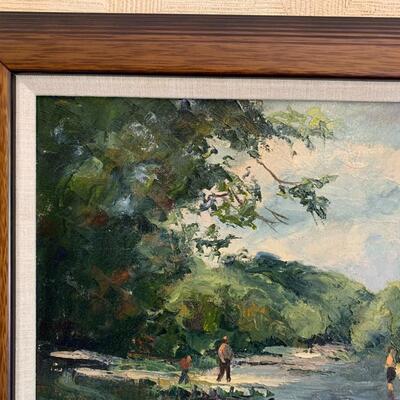
An exceptional painting by Mary Creamer! Scroll down to read bio. \/ Canvas Measures: 19 1/4" wide x 16" height Frame Measures: 22 1/4" wide x 20 3/4" height American artist Mary Creamer, active ca. 1925 - 1975, was a teacher and painter of portraiture, the figure, still-life and landscape in both oil and watercolor. Absent any birth, census (pre-1940), marriage, or death records in this name, Creamer's biographical details remained almost wholly hidden, and details of her artistic career not pursued, until the recent September 2011 location of a painting signed "Mary Creamer" with an original label verso bearing her un-wed sister's name.(1) Mary Creamer was born Edna Pearl King to James Robert King and Leona L. (Weldon) King in Hart Co, KY on 23 April 1892. (2) Her seamstress mother, Leona, by 1910 twice divorced and single, had moved with her two daughters Edna "Mary" and Bernice, from Kentucky to Indiana. In that year (1910), Mary, age 17, was boarding with Indiana friends living in St. Louis MO. It was evidently there where she met the Missouri native Charles P. Creamer; they were married on 14 April 1914. (3) The youthful Creamer took her earliest instruction in art in St. Louis, at Washington University; but it was sometime after 1920, following relocation to Oklahoma City, that during a lengthy hospital stay - when medical wisdom predicted a virtual certainty of losing her eyesight and perhaps her life - that Creamer was sustained by a commitment to becoming an artist, and immediately upon release entered the School of Art at the University of Oklahoma (Norman).(4) Creamer's Church in the Oil Fields, painted in her first semester there, took a second prize in a state show; impressed by the young artist's talent, instructor Genoa Morris (5) arranged for a local exhibition of Creamer's work, at which eighteen paintings immediately sold [LAJ]. From her home in Oklahoma City Creamer would frequently thereafter travel to study, paint and exhibit both in the east and in the west. Early on, in the East, she worked with Margaret Fitzhugh Browne (1887-1972) in Boston: from her Creamer was doubtless able to develop her facility in figure-painting, as well as the floral still-life, in both of which Browne excelled. In addition to time in Gloucester and Springfield Massachusetts, Creamer also took instruction with the noted watercolorist, instructor and author Eliot O'Hara ([1890-1969] likely in New York but possibly Maine). By the mid-1930s Creamer had - on the evidence, typically over summers - begun painting trips in the other direction, first in Taos NM, and soon thereafter in Santa Fe.(6) The call of the Southwest would eventually find Mary Creamer and her husband moving to southern California, sometime after 1941. From there the painterly environs of Nevada, Arizona and New Mexico were relatively accessible; but there, too, in Los Angeles and especially Taos, did Creamer find a supportive and growing community of artists and teachers. Among the latter was William Frederick Foster (1883-1953), a native mid-westerner who studied first with Frank Duveneck in Cincinnati and then with Robert Henri and William Merritt Chase in New York. Foster worked primarily as an illustrator until 1930, and Creamer is likely to have known him from her earlier trips in NY: one is invited to wonder if Foster's influence as an illustrator, joined to the figure training with Browne, was influential in Mary Creamer's execution of In the Land of Nod, said to have "later won no fewer than eight awards in two years, four of them juried in New York." (7) Having moved to Los Angeles in 1932, Foster taught at the Chouinard School of Art and also gave private classes in his own studio: it is presumably there that Creamer took further training from him. Both were active members of the California Arts Association (Los Angeles), as was the younger artist and teacher Nell Walker Warner (1891-1970). Creamer doubtless knew Warner during the latter's years as a young teacher in the Los Angeles area, and perhaps also from their common interests harbor scenes: both had traveled widely, including to Europe but also visiting Gloucester to paint, and when Warner moved north to the ocean-side art colony of Carmel CA in 1952, Creamer spent time with her there.(8) Mary Creamer lived in Dana Point (near Laguna Beach), San Diego, and Banning, but by mid-60s was traveling with enough regularity to paint, exhibit and teach in Arizona, Nevada, and New Mexico that in 1964 she and her husband established a second "permanent residence at her Taos home" [TN1] that summer. It was near this time, "by way of rounding out her ability as a portrait artist," that she learned from the noted painter Henry Balink (1882-1963) in Santa Fe how to "render the flesh tones and physical forms" of native American Indians: her canvas entitled My Son is reported [LAJ] to have won many awards and "prompted the Taos masters to request the same models, [and] the same pose too." In summers she taught classes at Taos, Carson City, and Reno, exhibiting her traditional representational art - portraits, landscapes and still-life - at the Nevada Art Gallery / State Museum in Reno and at smaller galleries there (the Blue Door, Carson Furniture Gallery, the Village Gallery, etc.). (9) In shows, Mary Creamer had as of 1965 won 18 first prizes, 16 second awards, 15 honorable mentions, four purchase awards, three sweepstakes, and others. In 1967 she taught at South Plains College in Levelland TX [LAJ]. Thereafter she was an active participant in the California Art Club, remaining a member through 1979: in the November 1974 CAC show at their Westwood Galleries, she exhibited Window in the Sky, California Landscape, Hawaiian Inlet, and Morning in the Desert. Though sometimes rendering canvases in the impressionist style (see for example her excellent African Violet), Creamer was committed to traditional realist representations of her subjects - this, she said, "because I like God's ideas as they are. No one, anywhere, can improve on nature, and the human body is the highest expression of creation" [LAJ]. Mary Creamer was a member of the National Association of Women Artists (NY), Pen and Brush (NY), the National League of American Pen Women (Washington D.C.), the Springfield Art Association, the Springfield Art League (Springfield MA), the California Arts Club (Los Angeles), American Institute of Fine Arts (Los Angeles), San Diego Art Association, and the Desert Art Center (Palm Springs CA). She was listed in the '60s editions of Who's Who in the Midwest and Who's Who of American Women [TN1]. 186 / 591 -
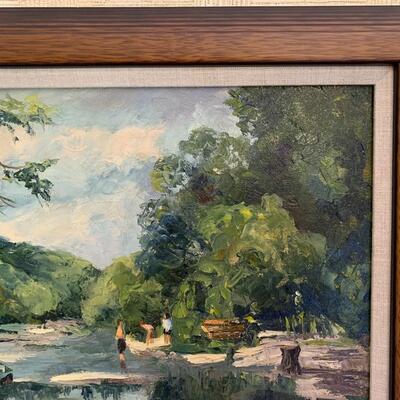
An exceptional painting by Mary Creamer! Scroll down to read bio. \/ Canvas Measures: 19 1/4" wide x 16" height Frame Measures: 22 1/4" wide x 20 3/4" height American artist Mary Creamer, active ca. 1925 - 1975, was a teacher and painter of portraiture, the figure, still-life and landscape in both oil and watercolor. Absent any birth, census (pre-1940), marriage, or death records in this name, Creamer's biographical details remained almost wholly hidden, and details of her artistic career not pursued, until the recent September 2011 location of a painting signed "Mary Creamer" with an original label verso bearing her un-wed sister's name.(1) Mary Creamer was born Edna Pearl King to James Robert King and Leona L. (Weldon) King in Hart Co, KY on 23 April 1892. (2) Her seamstress mother, Leona, by 1910 twice divorced and single, had moved with her two daughters Edna "Mary" and Bernice, from Kentucky to Indiana. In that year (1910), Mary, age 17, was boarding with Indiana friends living in St. Louis MO. It was evidently there where she met the Missouri native Charles P. Creamer; they were married on 14 April 1914. (3) The youthful Creamer took her earliest instruction in art in St. Louis, at Washington University; but it was sometime after 1920, following relocation to Oklahoma City, that during a lengthy hospital stay - when medical wisdom predicted a virtual certainty of losing her eyesight and perhaps her life - that Creamer was sustained by a commitment to becoming an artist, and immediately upon release entered the School of Art at the University of Oklahoma (Norman).(4) Creamer's Church in the Oil Fields, painted in her first semester there, took a second prize in a state show; impressed by the young artist's talent, instructor Genoa Morris (5) arranged for a local exhibition of Creamer's work, at which eighteen paintings immediately sold [LAJ]. From her home in Oklahoma City Creamer would frequently thereafter travel to study, paint and exhibit both in the east and in the west. Early on, in the East, she worked with Margaret Fitzhugh Browne (1887-1972) in Boston: from her Creamer was doubtless able to develop her facility in figure-painting, as well as the floral still-life, in both of which Browne excelled. In addition to time in Gloucester and Springfield Massachusetts, Creamer also took instruction with the noted watercolorist, instructor and author Eliot O'Hara ([1890-1969] likely in New York but possibly Maine). By the mid-1930s Creamer had - on the evidence, typically over summers - begun painting trips in the other direction, first in Taos NM, and soon thereafter in Santa Fe.(6) The call of the Southwest would eventually find Mary Creamer and her husband moving to southern California, sometime after 1941. From there the painterly environs of Nevada, Arizona and New Mexico were relatively accessible; but there, too, in Los Angeles and especially Taos, did Creamer find a supportive and growing community of artists and teachers. Among the latter was William Frederick Foster (1883-1953), a native mid-westerner who studied first with Frank Duveneck in Cincinnati and then with Robert Henri and William Merritt Chase in New York. Foster worked primarily as an illustrator until 1930, and Creamer is likely to have known him from her earlier trips in NY: one is invited to wonder if Foster's influence as an illustrator, joined to the figure training with Browne, was influential in Mary Creamer's execution of In the Land of Nod, said to have "later won no fewer than eight awards in two years, four of them juried in New York." (7) Having moved to Los Angeles in 1932, Foster taught at the Chouinard School of Art and also gave private classes in his own studio: it is presumably there that Creamer took further training from him. Both were active members of the California Arts Association (Los Angeles), as was the younger artist and teacher Nell Walker Warner (1891-1970). Creamer doubtless knew Warner during the latter's years as a young teacher in the Los Angeles area, and perhaps also from their common interests harbor scenes: both had traveled widely, including to Europe but also visiting Gloucester to paint, and when Warner moved north to the ocean-side art colony of Carmel CA in 1952, Creamer spent time with her there.(8) Mary Creamer lived in Dana Point (near Laguna Beach), San Diego, and Banning, but by mid-60s was traveling with enough regularity to paint, exhibit and teach in Arizona, Nevada, and New Mexico that in 1964 she and her husband established a second "permanent residence at her Taos home" [TN1] that summer. It was near this time, "by way of rounding out her ability as a portrait artist," that she learned from the noted painter Henry Balink (1882-1963) in Santa Fe how to "render the flesh tones and physical forms" of native American Indians: her canvas entitled My Son is reported [LAJ] to have won many awards and "prompted the Taos masters to request the same models, [and] the same pose too." In summers she taught classes at Taos, Carson City, and Reno, exhibiting her traditional representational art - portraits, landscapes and still-life - at the Nevada Art Gallery / State Museum in Reno and at smaller galleries there (the Blue Door, Carson Furniture Gallery, the Village Gallery, etc.). (9) In shows, Mary Creamer had as of 1965 won 18 first prizes, 16 second awards, 15 honorable mentions, four purchase awards, three sweepstakes, and others. In 1967 she taught at South Plains College in Levelland TX [LAJ]. Thereafter she was an active participant in the California Art Club, remaining a member through 1979: in the November 1974 CAC show at their Westwood Galleries, she exhibited Window in the Sky, California Landscape, Hawaiian Inlet, and Morning in the Desert. Though sometimes rendering canvases in the impressionist style (see for example her excellent African Violet), Creamer was committed to traditional realist representations of her subjects - this, she said, "because I like God's ideas as they are. No one, anywhere, can improve on nature, and the human body is the highest expression of creation" [LAJ]. Mary Creamer was a member of the National Association of Women Artists (NY), Pen and Brush (NY), the National League of American Pen Women (Washington D.C.), the Springfield Art Association, the Springfield Art League (Springfield MA), the California Arts Club (Los Angeles), American Institute of Fine Arts (Los Angeles), San Diego Art Association, and the Desert Art Center (Palm Springs CA). She was listed in the '60s editions of Who's Who in the Midwest and Who's Who of American Women [TN1]. 187 / 591 -

An exceptional painting by Mary Creamer! Scroll down to read bio. \/ Canvas Measures: 19 1/4" wide x 16" height Frame Measures: 22 1/4" wide x 20 3/4" height American artist Mary Creamer, active ca. 1925 - 1975, was a teacher and painter of portraiture, the figure, still-life and landscape in both oil and watercolor. Absent any birth, census (pre-1940), marriage, or death records in this name, Creamer's biographical details remained almost wholly hidden, and details of her artistic career not pursued, until the recent September 2011 location of a painting signed "Mary Creamer" with an original label verso bearing her un-wed sister's name.(1) Mary Creamer was born Edna Pearl King to James Robert King and Leona L. (Weldon) King in Hart Co, KY on 23 April 1892. (2) Her seamstress mother, Leona, by 1910 twice divorced and single, had moved with her two daughters Edna "Mary" and Bernice, from Kentucky to Indiana. In that year (1910), Mary, age 17, was boarding with Indiana friends living in St. Louis MO. It was evidently there where she met the Missouri native Charles P. Creamer; they were married on 14 April 1914. (3) The youthful Creamer took her earliest instruction in art in St. Louis, at Washington University; but it was sometime after 1920, following relocation to Oklahoma City, that during a lengthy hospital stay - when medical wisdom predicted a virtual certainty of losing her eyesight and perhaps her life - that Creamer was sustained by a commitment to becoming an artist, and immediately upon release entered the School of Art at the University of Oklahoma (Norman).(4) Creamer's Church in the Oil Fields, painted in her first semester there, took a second prize in a state show; impressed by the young artist's talent, instructor Genoa Morris (5) arranged for a local exhibition of Creamer's work, at which eighteen paintings immediately sold [LAJ]. From her home in Oklahoma City Creamer would frequently thereafter travel to study, paint and exhibit both in the east and in the west. Early on, in the East, she worked with Margaret Fitzhugh Browne (1887-1972) in Boston: from her Creamer was doubtless able to develop her facility in figure-painting, as well as the floral still-life, in both of which Browne excelled. In addition to time in Gloucester and Springfield Massachusetts, Creamer also took instruction with the noted watercolorist, instructor and author Eliot O'Hara ([1890-1969] likely in New York but possibly Maine). By the mid-1930s Creamer had - on the evidence, typically over summers - begun painting trips in the other direction, first in Taos NM, and soon thereafter in Santa Fe.(6) The call of the Southwest would eventually find Mary Creamer and her husband moving to southern California, sometime after 1941. From there the painterly environs of Nevada, Arizona and New Mexico were relatively accessible; but there, too, in Los Angeles and especially Taos, did Creamer find a supportive and growing community of artists and teachers. Among the latter was William Frederick Foster (1883-1953), a native mid-westerner who studied first with Frank Duveneck in Cincinnati and then with Robert Henri and William Merritt Chase in New York. Foster worked primarily as an illustrator until 1930, and Creamer is likely to have known him from her earlier trips in NY: one is invited to wonder if Foster's influence as an illustrator, joined to the figure training with Browne, was influential in Mary Creamer's execution of In the Land of Nod, said to have "later won no fewer than eight awards in two years, four of them juried in New York." (7) Having moved to Los Angeles in 1932, Foster taught at the Chouinard School of Art and also gave private classes in his own studio: it is presumably there that Creamer took further training from him. Both were active members of the California Arts Association (Los Angeles), as was the younger artist and teacher Nell Walker Warner (1891-1970). Creamer doubtless knew Warner during the latter's years as a young teacher in the Los Angeles area, and perhaps also from their common interests harbor scenes: both had traveled widely, including to Europe but also visiting Gloucester to paint, and when Warner moved north to the ocean-side art colony of Carmel CA in 1952, Creamer spent time with her there.(8) Mary Creamer lived in Dana Point (near Laguna Beach), San Diego, and Banning, but by mid-60s was traveling with enough regularity to paint, exhibit and teach in Arizona, Nevada, and New Mexico that in 1964 she and her husband established a second "permanent residence at her Taos home" [TN1] that summer. It was near this time, "by way of rounding out her ability as a portrait artist," that she learned from the noted painter Henry Balink (1882-1963) in Santa Fe how to "render the flesh tones and physical forms" of native American Indians: her canvas entitled My Son is reported [LAJ] to have won many awards and "prompted the Taos masters to request the same models, [and] the same pose too." In summers she taught classes at Taos, Carson City, and Reno, exhibiting her traditional representational art - portraits, landscapes and still-life - at the Nevada Art Gallery / State Museum in Reno and at smaller galleries there (the Blue Door, Carson Furniture Gallery, the Village Gallery, etc.). (9) In shows, Mary Creamer had as of 1965 won 18 first prizes, 16 second awards, 15 honorable mentions, four purchase awards, three sweepstakes, and others. In 1967 she taught at South Plains College in Levelland TX [LAJ]. Thereafter she was an active participant in the California Art Club, remaining a member through 1979: in the November 1974 CAC show at their Westwood Galleries, she exhibited Window in the Sky, California Landscape, Hawaiian Inlet, and Morning in the Desert. Though sometimes rendering canvases in the impressionist style (see for example her excellent African Violet), Creamer was committed to traditional realist representations of her subjects - this, she said, "because I like God's ideas as they are. No one, anywhere, can improve on nature, and the human body is the highest expression of creation" [LAJ]. Mary Creamer was a member of the National Association of Women Artists (NY), Pen and Brush (NY), the National League of American Pen Women (Washington D.C.), the Springfield Art Association, the Springfield Art League (Springfield MA), the California Arts Club (Los Angeles), American Institute of Fine Arts (Los Angeles), San Diego Art Association, and the Desert Art Center (Palm Springs CA). She was listed in the '60s editions of Who's Who in the Midwest and Who's Who of American Women [TN1]. 188 / 591 -
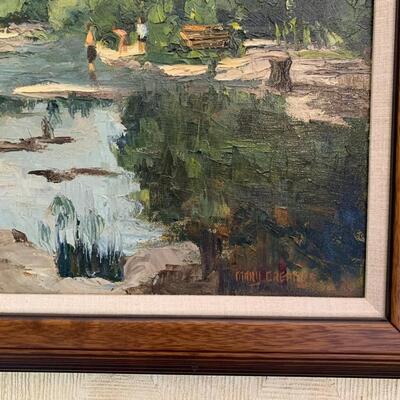
An exceptional painting by Mary Creamer! Scroll down to read bio. \/ Canvas Measures: 19 1/4" wide x 16" height Frame Measures: 22 1/4" wide x 20 3/4" height American artist Mary Creamer, active ca. 1925 - 1975, was a teacher and painter of portraiture, the figure, still-life and landscape in both oil and watercolor. Absent any birth, census (pre-1940), marriage, or death records in this name, Creamer's biographical details remained almost wholly hidden, and details of her artistic career not pursued, until the recent September 2011 location of a painting signed "Mary Creamer" with an original label verso bearing her un-wed sister's name.(1) Mary Creamer was born Edna Pearl King to James Robert King and Leona L. (Weldon) King in Hart Co, KY on 23 April 1892. (2) Her seamstress mother, Leona, by 1910 twice divorced and single, had moved with her two daughters Edna "Mary" and Bernice, from Kentucky to Indiana. In that year (1910), Mary, age 17, was boarding with Indiana friends living in St. Louis MO. It was evidently there where she met the Missouri native Charles P. Creamer; they were married on 14 April 1914. (3) The youthful Creamer took her earliest instruction in art in St. Louis, at Washington University; but it was sometime after 1920, following relocation to Oklahoma City, that during a lengthy hospital stay - when medical wisdom predicted a virtual certainty of losing her eyesight and perhaps her life - that Creamer was sustained by a commitment to becoming an artist, and immediately upon release entered the School of Art at the University of Oklahoma (Norman).(4) Creamer's Church in the Oil Fields, painted in her first semester there, took a second prize in a state show; impressed by the young artist's talent, instructor Genoa Morris (5) arranged for a local exhibition of Creamer's work, at which eighteen paintings immediately sold [LAJ]. From her home in Oklahoma City Creamer would frequently thereafter travel to study, paint and exhibit both in the east and in the west. Early on, in the East, she worked with Margaret Fitzhugh Browne (1887-1972) in Boston: from her Creamer was doubtless able to develop her facility in figure-painting, as well as the floral still-life, in both of which Browne excelled. In addition to time in Gloucester and Springfield Massachusetts, Creamer also took instruction with the noted watercolorist, instructor and author Eliot O'Hara ([1890-1969] likely in New York but possibly Maine). By the mid-1930s Creamer had - on the evidence, typically over summers - begun painting trips in the other direction, first in Taos NM, and soon thereafter in Santa Fe.(6) The call of the Southwest would eventually find Mary Creamer and her husband moving to southern California, sometime after 1941. From there the painterly environs of Nevada, Arizona and New Mexico were relatively accessible; but there, too, in Los Angeles and especially Taos, did Creamer find a supportive and growing community of artists and teachers. Among the latter was William Frederick Foster (1883-1953), a native mid-westerner who studied first with Frank Duveneck in Cincinnati and then with Robert Henri and William Merritt Chase in New York. Foster worked primarily as an illustrator until 1930, and Creamer is likely to have known him from her earlier trips in NY: one is invited to wonder if Foster's influence as an illustrator, joined to the figure training with Browne, was influential in Mary Creamer's execution of In the Land of Nod, said to have "later won no fewer than eight awards in two years, four of them juried in New York." (7) Having moved to Los Angeles in 1932, Foster taught at the Chouinard School of Art and also gave private classes in his own studio: it is presumably there that Creamer took further training from him. Both were active members of the California Arts Association (Los Angeles), as was the younger artist and teacher Nell Walker Warner (1891-1970). Creamer doubtless knew Warner during the latter's years as a young teacher in the Los Angeles area, and perhaps also from their common interests harbor scenes: both had traveled widely, including to Europe but also visiting Gloucester to paint, and when Warner moved north to the ocean-side art colony of Carmel CA in 1952, Creamer spent time with her there.(8) Mary Creamer lived in Dana Point (near Laguna Beach), San Diego, and Banning, but by mid-60s was traveling with enough regularity to paint, exhibit and teach in Arizona, Nevada, and New Mexico that in 1964 she and her husband established a second "permanent residence at her Taos home" [TN1] that summer. It was near this time, "by way of rounding out her ability as a portrait artist," that she learned from the noted painter Henry Balink (1882-1963) in Santa Fe how to "render the flesh tones and physical forms" of native American Indians: her canvas entitled My Son is reported [LAJ] to have won many awards and "prompted the Taos masters to request the same models, [and] the same pose too." In summers she taught classes at Taos, Carson City, and Reno, exhibiting her traditional representational art - portraits, landscapes and still-life - at the Nevada Art Gallery / State Museum in Reno and at smaller galleries there (the Blue Door, Carson Furniture Gallery, the Village Gallery, etc.). (9) In shows, Mary Creamer had as of 1965 won 18 first prizes, 16 second awards, 15 honorable mentions, four purchase awards, three sweepstakes, and others. In 1967 she taught at South Plains College in Levelland TX [LAJ]. Thereafter she was an active participant in the California Art Club, remaining a member through 1979: in the November 1974 CAC show at their Westwood Galleries, she exhibited Window in the Sky, California Landscape, Hawaiian Inlet, and Morning in the Desert. Though sometimes rendering canvases in the impressionist style (see for example her excellent African Violet), Creamer was committed to traditional realist representations of her subjects - this, she said, "because I like God's ideas as they are. No one, anywhere, can improve on nature, and the human body is the highest expression of creation" [LAJ]. Mary Creamer was a member of the National Association of Women Artists (NY), Pen and Brush (NY), the National League of American Pen Women (Washington D.C.), the Springfield Art Association, the Springfield Art League (Springfield MA), the California Arts Club (Los Angeles), American Institute of Fine Arts (Los Angeles), San Diego Art Association, and the Desert Art Center (Palm Springs CA). She was listed in the '60s editions of Who's Who in the Midwest and Who's Who of American Women [TN1]. 189 / 591 -
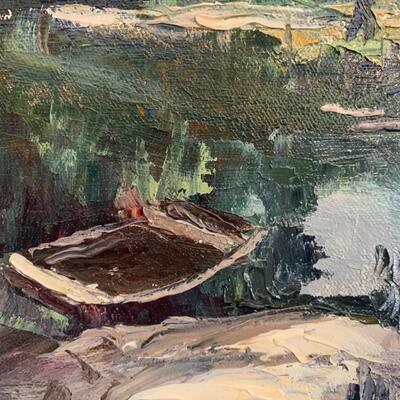
An exceptional painting by Mary Creamer! Scroll down to read bio. \/ Canvas Measures: 19 1/4" wide x 16" height Frame Measures: 22 1/4" wide x 20 3/4" height American artist Mary Creamer, active ca. 1925 - 1975, was a teacher and painter of portraiture, the figure, still-life and landscape in both oil and watercolor. Absent any birth, census (pre-1940), marriage, or death records in this name, Creamer's biographical details remained almost wholly hidden, and details of her artistic career not pursued, until the recent September 2011 location of a painting signed "Mary Creamer" with an original label verso bearing her un-wed sister's name.(1) Mary Creamer was born Edna Pearl King to James Robert King and Leona L. (Weldon) King in Hart Co, KY on 23 April 1892. (2) Her seamstress mother, Leona, by 1910 twice divorced and single, had moved with her two daughters Edna "Mary" and Bernice, from Kentucky to Indiana. In that year (1910), Mary, age 17, was boarding with Indiana friends living in St. Louis MO. It was evidently there where she met the Missouri native Charles P. Creamer; they were married on 14 April 1914. (3) The youthful Creamer took her earliest instruction in art in St. Louis, at Washington University; but it was sometime after 1920, following relocation to Oklahoma City, that during a lengthy hospital stay - when medical wisdom predicted a virtual certainty of losing her eyesight and perhaps her life - that Creamer was sustained by a commitment to becoming an artist, and immediately upon release entered the School of Art at the University of Oklahoma (Norman).(4) Creamer's Church in the Oil Fields, painted in her first semester there, took a second prize in a state show; impressed by the young artist's talent, instructor Genoa Morris (5) arranged for a local exhibition of Creamer's work, at which eighteen paintings immediately sold [LAJ]. From her home in Oklahoma City Creamer would frequently thereafter travel to study, paint and exhibit both in the east and in the west. Early on, in the East, she worked with Margaret Fitzhugh Browne (1887-1972) in Boston: from her Creamer was doubtless able to develop her facility in figure-painting, as well as the floral still-life, in both of which Browne excelled. In addition to time in Gloucester and Springfield Massachusetts, Creamer also took instruction with the noted watercolorist, instructor and author Eliot O'Hara ([1890-1969] likely in New York but possibly Maine). By the mid-1930s Creamer had - on the evidence, typically over summers - begun painting trips in the other direction, first in Taos NM, and soon thereafter in Santa Fe.(6) The call of the Southwest would eventually find Mary Creamer and her husband moving to southern California, sometime after 1941. From there the painterly environs of Nevada, Arizona and New Mexico were relatively accessible; but there, too, in Los Angeles and especially Taos, did Creamer find a supportive and growing community of artists and teachers. Among the latter was William Frederick Foster (1883-1953), a native mid-westerner who studied first with Frank Duveneck in Cincinnati and then with Robert Henri and William Merritt Chase in New York. Foster worked primarily as an illustrator until 1930, and Creamer is likely to have known him from her earlier trips in NY: one is invited to wonder if Foster's influence as an illustrator, joined to the figure training with Browne, was influential in Mary Creamer's execution of In the Land of Nod, said to have "later won no fewer than eight awards in two years, four of them juried in New York." (7) Having moved to Los Angeles in 1932, Foster taught at the Chouinard School of Art and also gave private classes in his own studio: it is presumably there that Creamer took further training from him. Both were active members of the California Arts Association (Los Angeles), as was the younger artist and teacher Nell Walker Warner (1891-1970). Creamer doubtless knew Warner during the latter's years as a young teacher in the Los Angeles area, and perhaps also from their common interests harbor scenes: both had traveled widely, including to Europe but also visiting Gloucester to paint, and when Warner moved north to the ocean-side art colony of Carmel CA in 1952, Creamer spent time with her there.(8) Mary Creamer lived in Dana Point (near Laguna Beach), San Diego, and Banning, but by mid-60s was traveling with enough regularity to paint, exhibit and teach in Arizona, Nevada, and New Mexico that in 1964 she and her husband established a second "permanent residence at her Taos home" [TN1] that summer. It was near this time, "by way of rounding out her ability as a portrait artist," that she learned from the noted painter Henry Balink (1882-1963) in Santa Fe how to "render the flesh tones and physical forms" of native American Indians: her canvas entitled My Son is reported [LAJ] to have won many awards and "prompted the Taos masters to request the same models, [and] the same pose too." In summers she taught classes at Taos, Carson City, and Reno, exhibiting her traditional representational art - portraits, landscapes and still-life - at the Nevada Art Gallery / State Museum in Reno and at smaller galleries there (the Blue Door, Carson Furniture Gallery, the Village Gallery, etc.). (9) In shows, Mary Creamer had as of 1965 won 18 first prizes, 16 second awards, 15 honorable mentions, four purchase awards, three sweepstakes, and others. In 1967 she taught at South Plains College in Levelland TX [LAJ]. Thereafter she was an active participant in the California Art Club, remaining a member through 1979: in the November 1974 CAC show at their Westwood Galleries, she exhibited Window in the Sky, California Landscape, Hawaiian Inlet, and Morning in the Desert. Though sometimes rendering canvases in the impressionist style (see for example her excellent African Violet), Creamer was committed to traditional realist representations of her subjects - this, she said, "because I like God's ideas as they are. No one, anywhere, can improve on nature, and the human body is the highest expression of creation" [LAJ]. Mary Creamer was a member of the National Association of Women Artists (NY), Pen and Brush (NY), the National League of American Pen Women (Washington D.C.), the Springfield Art Association, the Springfield Art League (Springfield MA), the California Arts Club (Los Angeles), American Institute of Fine Arts (Los Angeles), San Diego Art Association, and the Desert Art Center (Palm Springs CA). She was listed in the '60s editions of Who's Who in the Midwest and Who's Who of American Women [TN1]. 190 / 591 -
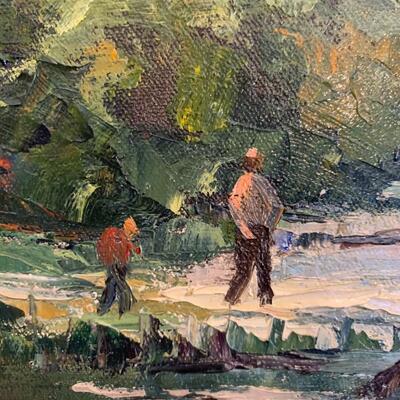
An exceptional painting by Mary Creamer! Scroll down to read bio. \/ Canvas Measures: 19 1/4" wide x 16" height Frame Measures: 22 1/4" wide x 20 3/4" height American artist Mary Creamer, active ca. 1925 - 1975, was a teacher and painter of portraiture, the figure, still-life and landscape in both oil and watercolor. Absent any birth, census (pre-1940), marriage, or death records in this name, Creamer's biographical details remained almost wholly hidden, and details of her artistic career not pursued, until the recent September 2011 location of a painting signed "Mary Creamer" with an original label verso bearing her un-wed sister's name.(1) Mary Creamer was born Edna Pearl King to James Robert King and Leona L. (Weldon) King in Hart Co, KY on 23 April 1892. (2) Her seamstress mother, Leona, by 1910 twice divorced and single, had moved with her two daughters Edna "Mary" and Bernice, from Kentucky to Indiana. In that year (1910), Mary, age 17, was boarding with Indiana friends living in St. Louis MO. It was evidently there where she met the Missouri native Charles P. Creamer; they were married on 14 April 1914. (3) The youthful Creamer took her earliest instruction in art in St. Louis, at Washington University; but it was sometime after 1920, following relocation to Oklahoma City, that during a lengthy hospital stay - when medical wisdom predicted a virtual certainty of losing her eyesight and perhaps her life - that Creamer was sustained by a commitment to becoming an artist, and immediately upon release entered the School of Art at the University of Oklahoma (Norman).(4) Creamer's Church in the Oil Fields, painted in her first semester there, took a second prize in a state show; impressed by the young artist's talent, instructor Genoa Morris (5) arranged for a local exhibition of Creamer's work, at which eighteen paintings immediately sold [LAJ]. From her home in Oklahoma City Creamer would frequently thereafter travel to study, paint and exhibit both in the east and in the west. Early on, in the East, she worked with Margaret Fitzhugh Browne (1887-1972) in Boston: from her Creamer was doubtless able to develop her facility in figure-painting, as well as the floral still-life, in both of which Browne excelled. In addition to time in Gloucester and Springfield Massachusetts, Creamer also took instruction with the noted watercolorist, instructor and author Eliot O'Hara ([1890-1969] likely in New York but possibly Maine). By the mid-1930s Creamer had - on the evidence, typically over summers - begun painting trips in the other direction, first in Taos NM, and soon thereafter in Santa Fe.(6) The call of the Southwest would eventually find Mary Creamer and her husband moving to southern California, sometime after 1941. From there the painterly environs of Nevada, Arizona and New Mexico were relatively accessible; but there, too, in Los Angeles and especially Taos, did Creamer find a supportive and growing community of artists and teachers. Among the latter was William Frederick Foster (1883-1953), a native mid-westerner who studied first with Frank Duveneck in Cincinnati and then with Robert Henri and William Merritt Chase in New York. Foster worked primarily as an illustrator until 1930, and Creamer is likely to have known him from her earlier trips in NY: one is invited to wonder if Foster's influence as an illustrator, joined to the figure training with Browne, was influential in Mary Creamer's execution of In the Land of Nod, said to have "later won no fewer than eight awards in two years, four of them juried in New York." (7) Having moved to Los Angeles in 1932, Foster taught at the Chouinard School of Art and also gave private classes in his own studio: it is presumably there that Creamer took further training from him. Both were active members of the California Arts Association (Los Angeles), as was the younger artist and teacher Nell Walker Warner (1891-1970). Creamer doubtless knew Warner during the latter's years as a young teacher in the Los Angeles area, and perhaps also from their common interests harbor scenes: both had traveled widely, including to Europe but also visiting Gloucester to paint, and when Warner moved north to the ocean-side art colony of Carmel CA in 1952, Creamer spent time with her there.(8) Mary Creamer lived in Dana Point (near Laguna Beach), San Diego, and Banning, but by mid-60s was traveling with enough regularity to paint, exhibit and teach in Arizona, Nevada, and New Mexico that in 1964 she and her husband established a second "permanent residence at her Taos home" [TN1] that summer. It was near this time, "by way of rounding out her ability as a portrait artist," that she learned from the noted painter Henry Balink (1882-1963) in Santa Fe how to "render the flesh tones and physical forms" of native American Indians: her canvas entitled My Son is reported [LAJ] to have won many awards and "prompted the Taos masters to request the same models, [and] the same pose too." In summers she taught classes at Taos, Carson City, and Reno, exhibiting her traditional representational art - portraits, landscapes and still-life - at the Nevada Art Gallery / State Museum in Reno and at smaller galleries there (the Blue Door, Carson Furniture Gallery, the Village Gallery, etc.). (9) In shows, Mary Creamer had as of 1965 won 18 first prizes, 16 second awards, 15 honorable mentions, four purchase awards, three sweepstakes, and others. In 1967 she taught at South Plains College in Levelland TX [LAJ]. Thereafter she was an active participant in the California Art Club, remaining a member through 1979: in the November 1974 CAC show at their Westwood Galleries, she exhibited Window in the Sky, California Landscape, Hawaiian Inlet, and Morning in the Desert. Though sometimes rendering canvases in the impressionist style (see for example her excellent African Violet), Creamer was committed to traditional realist representations of her subjects - this, she said, "because I like God's ideas as they are. No one, anywhere, can improve on nature, and the human body is the highest expression of creation" [LAJ]. Mary Creamer was a member of the National Association of Women Artists (NY), Pen and Brush (NY), the National League of American Pen Women (Washington D.C.), the Springfield Art Association, the Springfield Art League (Springfield MA), the California Arts Club (Los Angeles), American Institute of Fine Arts (Los Angeles), San Diego Art Association, and the Desert Art Center (Palm Springs CA). She was listed in the '60s editions of Who's Who in the Midwest and Who's Who of American Women [TN1]. 191 / 591 -
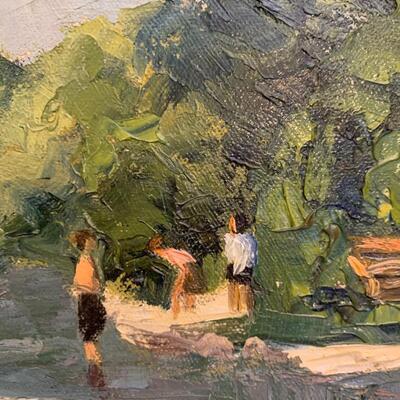
An exceptional painting by Mary Creamer! Scroll down to read bio. \/ Canvas Measures: 19 1/4" wide x 16" height Frame Measures: 22 1/4" wide x 20 3/4" height American artist Mary Creamer, active ca. 1925 - 1975, was a teacher and painter of portraiture, the figure, still-life and landscape in both oil and watercolor. Absent any birth, census (pre-1940), marriage, or death records in this name, Creamer's biographical details remained almost wholly hidden, and details of her artistic career not pursued, until the recent September 2011 location of a painting signed "Mary Creamer" with an original label verso bearing her un-wed sister's name.(1) Mary Creamer was born Edna Pearl King to James Robert King and Leona L. (Weldon) King in Hart Co, KY on 23 April 1892. (2) Her seamstress mother, Leona, by 1910 twice divorced and single, had moved with her two daughters Edna "Mary" and Bernice, from Kentucky to Indiana. In that year (1910), Mary, age 17, was boarding with Indiana friends living in St. Louis MO. It was evidently there where she met the Missouri native Charles P. Creamer; they were married on 14 April 1914. (3) The youthful Creamer took her earliest instruction in art in St. Louis, at Washington University; but it was sometime after 1920, following relocation to Oklahoma City, that during a lengthy hospital stay - when medical wisdom predicted a virtual certainty of losing her eyesight and perhaps her life - that Creamer was sustained by a commitment to becoming an artist, and immediately upon release entered the School of Art at the University of Oklahoma (Norman).(4) Creamer's Church in the Oil Fields, painted in her first semester there, took a second prize in a state show; impressed by the young artist's talent, instructor Genoa Morris (5) arranged for a local exhibition of Creamer's work, at which eighteen paintings immediately sold [LAJ]. From her home in Oklahoma City Creamer would frequently thereafter travel to study, paint and exhibit both in the east and in the west. Early on, in the East, she worked with Margaret Fitzhugh Browne (1887-1972) in Boston: from her Creamer was doubtless able to develop her facility in figure-painting, as well as the floral still-life, in both of which Browne excelled. In addition to time in Gloucester and Springfield Massachusetts, Creamer also took instruction with the noted watercolorist, instructor and author Eliot O'Hara ([1890-1969] likely in New York but possibly Maine). By the mid-1930s Creamer had - on the evidence, typically over summers - begun painting trips in the other direction, first in Taos NM, and soon thereafter in Santa Fe.(6) The call of the Southwest would eventually find Mary Creamer and her husband moving to southern California, sometime after 1941. From there the painterly environs of Nevada, Arizona and New Mexico were relatively accessible; but there, too, in Los Angeles and especially Taos, did Creamer find a supportive and growing community of artists and teachers. Among the latter was William Frederick Foster (1883-1953), a native mid-westerner who studied first with Frank Duveneck in Cincinnati and then with Robert Henri and William Merritt Chase in New York. Foster worked primarily as an illustrator until 1930, and Creamer is likely to have known him from her earlier trips in NY: one is invited to wonder if Foster's influence as an illustrator, joined to the figure training with Browne, was influential in Mary Creamer's execution of In the Land of Nod, said to have "later won no fewer than eight awards in two years, four of them juried in New York." (7) Having moved to Los Angeles in 1932, Foster taught at the Chouinard School of Art and also gave private classes in his own studio: it is presumably there that Creamer took further training from him. Both were active members of the California Arts Association (Los Angeles), as was the younger artist and teacher Nell Walker Warner (1891-1970). Creamer doubtless knew Warner during the latter's years as a young teacher in the Los Angeles area, and perhaps also from their common interests harbor scenes: both had traveled widely, including to Europe but also visiting Gloucester to paint, and when Warner moved north to the ocean-side art colony of Carmel CA in 1952, Creamer spent time with her there.(8) Mary Creamer lived in Dana Point (near Laguna Beach), San Diego, and Banning, but by mid-60s was traveling with enough regularity to paint, exhibit and teach in Arizona, Nevada, and New Mexico that in 1964 she and her husband established a second "permanent residence at her Taos home" [TN1] that summer. It was near this time, "by way of rounding out her ability as a portrait artist," that she learned from the noted painter Henry Balink (1882-1963) in Santa Fe how to "render the flesh tones and physical forms" of native American Indians: her canvas entitled My Son is reported [LAJ] to have won many awards and "prompted the Taos masters to request the same models, [and] the same pose too." In summers she taught classes at Taos, Carson City, and Reno, exhibiting her traditional representational art - portraits, landscapes and still-life - at the Nevada Art Gallery / State Museum in Reno and at smaller galleries there (the Blue Door, Carson Furniture Gallery, the Village Gallery, etc.). (9) In shows, Mary Creamer had as of 1965 won 18 first prizes, 16 second awards, 15 honorable mentions, four purchase awards, three sweepstakes, and others. In 1967 she taught at South Plains College in Levelland TX [LAJ]. Thereafter she was an active participant in the California Art Club, remaining a member through 1979: in the November 1974 CAC show at their Westwood Galleries, she exhibited Window in the Sky, California Landscape, Hawaiian Inlet, and Morning in the Desert. Though sometimes rendering canvases in the impressionist style (see for example her excellent African Violet), Creamer was committed to traditional realist representations of her subjects - this, she said, "because I like God's ideas as they are. No one, anywhere, can improve on nature, and the human body is the highest expression of creation" [LAJ]. Mary Creamer was a member of the National Association of Women Artists (NY), Pen and Brush (NY), the National League of American Pen Women (Washington D.C.), the Springfield Art Association, the Springfield Art League (Springfield MA), the California Arts Club (Los Angeles), American Institute of Fine Arts (Los Angeles), San Diego Art Association, and the Desert Art Center (Palm Springs CA). She was listed in the '60s editions of Who's Who in the Midwest and Who's Who of American Women [TN1]. 192 / 591 -
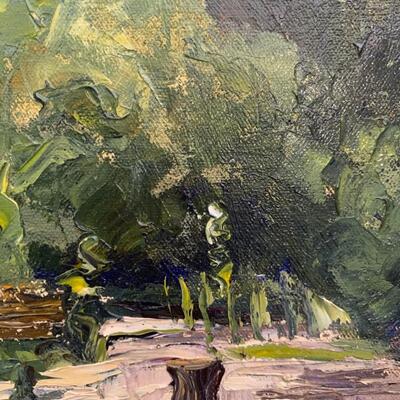
An exceptional painting by Mary Creamer! Scroll down to read bio. \/ Canvas Measures: 19 1/4" wide x 16" height Frame Measures: 22 1/4" wide x 20 3/4" height American artist Mary Creamer, active ca. 1925 - 1975, was a teacher and painter of portraiture, the figure, still-life and landscape in both oil and watercolor. Absent any birth, census (pre-1940), marriage, or death records in this name, Creamer's biographical details remained almost wholly hidden, and details of her artistic career not pursued, until the recent September 2011 location of a painting signed "Mary Creamer" with an original label verso bearing her un-wed sister's name.(1) Mary Creamer was born Edna Pearl King to James Robert King and Leona L. (Weldon) King in Hart Co, KY on 23 April 1892. (2) Her seamstress mother, Leona, by 1910 twice divorced and single, had moved with her two daughters Edna "Mary" and Bernice, from Kentucky to Indiana. In that year (1910), Mary, age 17, was boarding with Indiana friends living in St. Louis MO. It was evidently there where she met the Missouri native Charles P. Creamer; they were married on 14 April 1914. (3) The youthful Creamer took her earliest instruction in art in St. Louis, at Washington University; but it was sometime after 1920, following relocation to Oklahoma City, that during a lengthy hospital stay - when medical wisdom predicted a virtual certainty of losing her eyesight and perhaps her life - that Creamer was sustained by a commitment to becoming an artist, and immediately upon release entered the School of Art at the University of Oklahoma (Norman).(4) Creamer's Church in the Oil Fields, painted in her first semester there, took a second prize in a state show; impressed by the young artist's talent, instructor Genoa Morris (5) arranged for a local exhibition of Creamer's work, at which eighteen paintings immediately sold [LAJ]. From her home in Oklahoma City Creamer would frequently thereafter travel to study, paint and exhibit both in the east and in the west. Early on, in the East, she worked with Margaret Fitzhugh Browne (1887-1972) in Boston: from her Creamer was doubtless able to develop her facility in figure-painting, as well as the floral still-life, in both of which Browne excelled. In addition to time in Gloucester and Springfield Massachusetts, Creamer also took instruction with the noted watercolorist, instructor and author Eliot O'Hara ([1890-1969] likely in New York but possibly Maine). By the mid-1930s Creamer had - on the evidence, typically over summers - begun painting trips in the other direction, first in Taos NM, and soon thereafter in Santa Fe.(6) The call of the Southwest would eventually find Mary Creamer and her husband moving to southern California, sometime after 1941. From there the painterly environs of Nevada, Arizona and New Mexico were relatively accessible; but there, too, in Los Angeles and especially Taos, did Creamer find a supportive and growing community of artists and teachers. Among the latter was William Frederick Foster (1883-1953), a native mid-westerner who studied first with Frank Duveneck in Cincinnati and then with Robert Henri and William Merritt Chase in New York. Foster worked primarily as an illustrator until 1930, and Creamer is likely to have known him from her earlier trips in NY: one is invited to wonder if Foster's influence as an illustrator, joined to the figure training with Browne, was influential in Mary Creamer's execution of In the Land of Nod, said to have "later won no fewer than eight awards in two years, four of them juried in New York." (7) Having moved to Los Angeles in 1932, Foster taught at the Chouinard School of Art and also gave private classes in his own studio: it is presumably there that Creamer took further training from him. Both were active members of the California Arts Association (Los Angeles), as was the younger artist and teacher Nell Walker Warner (1891-1970). Creamer doubtless knew Warner during the latter's years as a young teacher in the Los Angeles area, and perhaps also from their common interests harbor scenes: both had traveled widely, including to Europe but also visiting Gloucester to paint, and when Warner moved north to the ocean-side art colony of Carmel CA in 1952, Creamer spent time with her there.(8) Mary Creamer lived in Dana Point (near Laguna Beach), San Diego, and Banning, but by mid-60s was traveling with enough regularity to paint, exhibit and teach in Arizona, Nevada, and New Mexico that in 1964 she and her husband established a second "permanent residence at her Taos home" [TN1] that summer. It was near this time, "by way of rounding out her ability as a portrait artist," that she learned from the noted painter Henry Balink (1882-1963) in Santa Fe how to "render the flesh tones and physical forms" of native American Indians: her canvas entitled My Son is reported [LAJ] to have won many awards and "prompted the Taos masters to request the same models, [and] the same pose too." In summers she taught classes at Taos, Carson City, and Reno, exhibiting her traditional representational art - portraits, landscapes and still-life - at the Nevada Art Gallery / State Museum in Reno and at smaller galleries there (the Blue Door, Carson Furniture Gallery, the Village Gallery, etc.). (9) In shows, Mary Creamer had as of 1965 won 18 first prizes, 16 second awards, 15 honorable mentions, four purchase awards, three sweepstakes, and others. In 1967 she taught at South Plains College in Levelland TX [LAJ]. Thereafter she was an active participant in the California Art Club, remaining a member through 1979: in the November 1974 CAC show at their Westwood Galleries, she exhibited Window in the Sky, California Landscape, Hawaiian Inlet, and Morning in the Desert. Though sometimes rendering canvases in the impressionist style (see for example her excellent African Violet), Creamer was committed to traditional realist representations of her subjects - this, she said, "because I like God's ideas as they are. No one, anywhere, can improve on nature, and the human body is the highest expression of creation" [LAJ]. Mary Creamer was a member of the National Association of Women Artists (NY), Pen and Brush (NY), the National League of American Pen Women (Washington D.C.), the Springfield Art Association, the Springfield Art League (Springfield MA), the California Arts Club (Los Angeles), American Institute of Fine Arts (Los Angeles), San Diego Art Association, and the Desert Art Center (Palm Springs CA). She was listed in the '60s editions of Who's Who in the Midwest and Who's Who of American Women [TN1]. 193 / 591 -
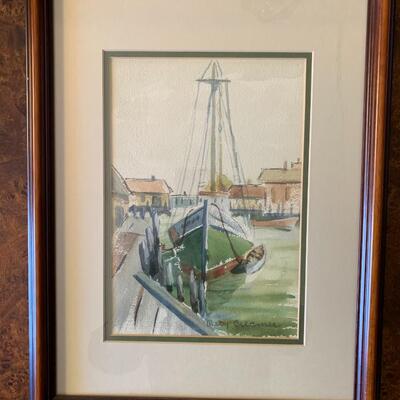
A timeless painting of a sailboat at the dock. Scroll down to read Mary Creamer's bio. \/ Painting measures: 7 1/2' wide x 10 3/4" height Frame measures: 13 3/4" wide x 17 3/4" height American artist Mary Creamer, active ca. 1925 - 1975, was a teacher and painter of portraiture, the figure, still-life and landscape in both oil and watercolor. Absent any birth, census (pre-1940), marriage, or death records in this name, Creamer's biographical details remained almost wholly hidden, and details of her artistic career not pursued, until the recent September 2011 location of a painting signed "Mary Creamer" with an original label verso bearing her un-wed sister's name.(1) Mary Creamer was born Edna Pearl King to James Robert King and Leona L. (Weldon) King in Hart Co, KY on 23 April 1892. (2) Her seamstress mother, Leona, by 1910 twice divorced and single, had moved with her two daughters Edna "Mary" and Bernice, from Kentucky to Indiana. In that year (1910), Mary, age 17, was boarding with Indiana friends living in St. Louis MO. It was evidently there where she met the Missouri native Charles P. Creamer; they were married on 14 April 1914. (3) The youthful Creamer took her earliest instruction in art in St. Louis, at Washington University; but it was sometime after 1920, following relocation to Oklahoma City, that during a lengthy hospital stay - when medical wisdom predicted a virtual certainty of losing her eyesight and perhaps her life - that Creamer was sustained by a commitment to becoming an artist, and immediately upon release entered the School of Art at the University of Oklahoma (Norman).(4) Creamer's Church in the Oil Fields, painted in her first semester there, took a second prize in a state show; impressed by the young artist's talent, instructor Genoa Morris (5) arranged for a local exhibition of Creamer's work, at which eighteen paintings immediately sold [LAJ]. From her home in Oklahoma City Creamer would frequently thereafter travel to study, paint and exhibit both in the east and in the west. Early on, in the East, she worked with Margaret Fitzhugh Browne (1887-1972) in Boston: from her Creamer was doubtless able to develop her facility in figure-painting, as well as the floral still-life, in both of which Browne excelled. In addition to time in Gloucester and Springfield Massachusetts, Creamer also took instruction with the noted watercolorist, instructor and author Eliot O'Hara ([1890-1969] likely in New York but possibly Maine). By the mid-1930s Creamer had - on the evidence, typically over summers - begun painting trips in the other direction, first in Taos NM, and soon thereafter in Santa Fe.(6) The call of the Southwest would eventually find Mary Creamer and her husband moving to southern California, sometime after 1941. From there the painterly environs of Nevada, Arizona and New Mexico were relatively accessible; but there, too, in Los Angeles and especially Taos, did Creamer find a supportive and growing community of artists and teachers. Among the latter was William Frederick Foster (1883-1953), a native mid-westerner who studied first with Frank Duveneck in Cincinnati and then with Robert Henri and William Merritt Chase in New York. Foster worked primarily as an illustrator until 1930, and Creamer is likely to have known him from her earlier trips in NY: one is invited to wonder if Foster's influence as an illustrator, joined to the figure training with Browne, was influential in Mary Creamer's execution of In the Land of Nod, said to have "later won no fewer than eight awards in two years, four of them juried in New York." (7) Having moved to Los Angeles in 1932, Foster taught at the Chouinard School of Art and also gave private classes in his own studio: it is presumably there that Creamer took further training from him. Both were active members of the California Arts Association (Los Angeles), as was the younger artist and teacher Nell Walker Warner (1891-1970). Creamer doubtless knew Warner during the latter's years as a young teacher in the Los Angeles area, and perhaps also from their common interests harbor scenes: both had traveled widely, including to Europe but also visiting Gloucester to paint, and when Warner moved north to the ocean-side art colony of Carmel CA in 1952, Creamer spent time with her there.(8) Mary Creamer lived in Dana Point (near Laguna Beach), San Diego, and Banning, but by mid-60s was traveling with enough regularity to paint, exhibit and teach in Arizona, Nevada, and New Mexico that in 1964 she and her husband established a second "permanent residence at her Taos home" [TN1] that summer. It was near this time, "by way of rounding out her ability as a portrait artist," that she learned from the noted painter Henry Balink (1882-1963) in Santa Fe how to "render the flesh tones and physical forms" of native American Indians: her canvas entitled My Son is reported [LAJ] to have won many awards and "prompted the Taos masters to request the same models, [and] the same pose too." In summers she taught classes at Taos, Carson City, and Reno, exhibiting her traditional representational art - portraits, landscapes and still-life - at the Nevada Art Gallery / State Museum in Reno and at smaller galleries there (the Blue Door, Carson Furniture Gallery, the Village Gallery, etc.). (9) In shows, Mary Creamer had as of 1965 won 18 first prizes, 16 second awards, 15 honorable mentions, four purchase awards, three sweepstakes, and others. In 1967 she taught at South Plains College in Levelland TX [LAJ]. Thereafter she was an active participant in the California Art Club, remaining a member through 1979: in the November 1974 CAC show at their Westwood Galleries, she exhibited Window in the Sky, California Landscape, Hawaiian Inlet, and Morning in the Desert. Though sometimes rendering canvases in the impressionist style (see for example her excellent African Violet), Creamer was committed to traditional realist representations of her subjects - this, she said, "because I like God's ideas as they are. No one, anywhere, can improve on nature, and the human body is the highest expression of creation" [LAJ]. Mary Creamer was a member of the National Association of Women Artists (NY), Pen and Brush (NY), the National League of American Pen Women (Washington D.C.), the Springfield Art Association, the Springfield Art League (Springfield MA), the California Arts Club (Los Angeles), American Institute of Fine Arts (Los Angeles), San Diego Art Association, and the Desert Art Center (Palm Springs CA). She was listed in the '60s editions of Who's Who in the Midwest and Who's Who of American Women [TN1]. 194 / 591 -
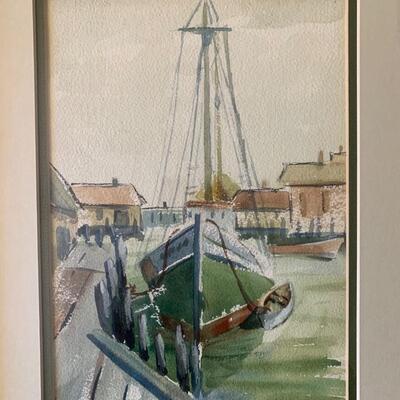
A timeless painting of a sailboat at the dock. Scroll down to read Mary Creamer's bio. \/ Painting measures: 7 1/2' wide x 10 3/4" height Frame measures: 13 3/4" wide x 17 3/4" height American artist Mary Creamer, active ca. 1925 - 1975, was a teacher and painter of portraiture, the figure, still-life and landscape in both oil and watercolor. Absent any birth, census (pre-1940), marriage, or death records in this name, Creamer's biographical details remained almost wholly hidden, and details of her artistic career not pursued, until the recent September 2011 location of a painting signed "Mary Creamer" with an original label verso bearing her un-wed sister's name.(1) Mary Creamer was born Edna Pearl King to James Robert King and Leona L. (Weldon) King in Hart Co, KY on 23 April 1892. (2) Her seamstress mother, Leona, by 1910 twice divorced and single, had moved with her two daughters Edna "Mary" and Bernice, from Kentucky to Indiana. In that year (1910), Mary, age 17, was boarding with Indiana friends living in St. Louis MO. It was evidently there where she met the Missouri native Charles P. Creamer; they were married on 14 April 1914. (3) The youthful Creamer took her earliest instruction in art in St. Louis, at Washington University; but it was sometime after 1920, following relocation to Oklahoma City, that during a lengthy hospital stay - when medical wisdom predicted a virtual certainty of losing her eyesight and perhaps her life - that Creamer was sustained by a commitment to becoming an artist, and immediately upon release entered the School of Art at the University of Oklahoma (Norman).(4) Creamer's Church in the Oil Fields, painted in her first semester there, took a second prize in a state show; impressed by the young artist's talent, instructor Genoa Morris (5) arranged for a local exhibition of Creamer's work, at which eighteen paintings immediately sold [LAJ]. From her home in Oklahoma City Creamer would frequently thereafter travel to study, paint and exhibit both in the east and in the west. Early on, in the East, she worked with Margaret Fitzhugh Browne (1887-1972) in Boston: from her Creamer was doubtless able to develop her facility in figure-painting, as well as the floral still-life, in both of which Browne excelled. In addition to time in Gloucester and Springfield Massachusetts, Creamer also took instruction with the noted watercolorist, instructor and author Eliot O'Hara ([1890-1969] likely in New York but possibly Maine). By the mid-1930s Creamer had - on the evidence, typically over summers - begun painting trips in the other direction, first in Taos NM, and soon thereafter in Santa Fe.(6) The call of the Southwest would eventually find Mary Creamer and her husband moving to southern California, sometime after 1941. From there the painterly environs of Nevada, Arizona and New Mexico were relatively accessible; but there, too, in Los Angeles and especially Taos, did Creamer find a supportive and growing community of artists and teachers. Among the latter was William Frederick Foster (1883-1953), a native mid-westerner who studied first with Frank Duveneck in Cincinnati and then with Robert Henri and William Merritt Chase in New York. Foster worked primarily as an illustrator until 1930, and Creamer is likely to have known him from her earlier trips in NY: one is invited to wonder if Foster's influence as an illustrator, joined to the figure training with Browne, was influential in Mary Creamer's execution of In the Land of Nod, said to have "later won no fewer than eight awards in two years, four of them juried in New York." (7) Having moved to Los Angeles in 1932, Foster taught at the Chouinard School of Art and also gave private classes in his own studio: it is presumably there that Creamer took further training from him. Both were active members of the California Arts Association (Los Angeles), as was the younger artist and teacher Nell Walker Warner (1891-1970). Creamer doubtless knew Warner during the latter's years as a young teacher in the Los Angeles area, and perhaps also from their common interests harbor scenes: both had traveled widely, including to Europe but also visiting Gloucester to paint, and when Warner moved north to the ocean-side art colony of Carmel CA in 1952, Creamer spent time with her there.(8) Mary Creamer lived in Dana Point (near Laguna Beach), San Diego, and Banning, but by mid-60s was traveling with enough regularity to paint, exhibit and teach in Arizona, Nevada, and New Mexico that in 1964 she and her husband established a second "permanent residence at her Taos home" [TN1] that summer. It was near this time, "by way of rounding out her ability as a portrait artist," that she learned from the noted painter Henry Balink (1882-1963) in Santa Fe how to "render the flesh tones and physical forms" of native American Indians: her canvas entitled My Son is reported [LAJ] to have won many awards and "prompted the Taos masters to request the same models, [and] the same pose too." In summers she taught classes at Taos, Carson City, and Reno, exhibiting her traditional representational art - portraits, landscapes and still-life - at the Nevada Art Gallery / State Museum in Reno and at smaller galleries there (the Blue Door, Carson Furniture Gallery, the Village Gallery, etc.). (9) In shows, Mary Creamer had as of 1965 won 18 first prizes, 16 second awards, 15 honorable mentions, four purchase awards, three sweepstakes, and others. In 1967 she taught at South Plains College in Levelland TX [LAJ]. Thereafter she was an active participant in the California Art Club, remaining a member through 1979: in the November 1974 CAC show at their Westwood Galleries, she exhibited Window in the Sky, California Landscape, Hawaiian Inlet, and Morning in the Desert. Though sometimes rendering canvases in the impressionist style (see for example her excellent African Violet), Creamer was committed to traditional realist representations of her subjects - this, she said, "because I like God's ideas as they are. No one, anywhere, can improve on nature, and the human body is the highest expression of creation" [LAJ]. Mary Creamer was a member of the National Association of Women Artists (NY), Pen and Brush (NY), the National League of American Pen Women (Washington D.C.), the Springfield Art Association, the Springfield Art League (Springfield MA), the California Arts Club (Los Angeles), American Institute of Fine Arts (Los Angeles), San Diego Art Association, and the Desert Art Center (Palm Springs CA). She was listed in the '60s editions of Who's Who in the Midwest and Who's Who of American Women [TN1]. 195 / 591 -
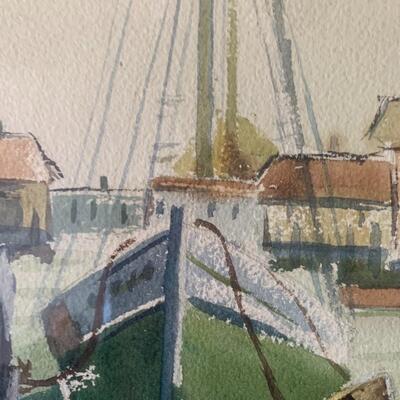
A timeless painting of a sailboat at the dock. Scroll down to read Mary Creamer's bio. \/ Painting measures: 7 1/2' wide x 10 3/4" height Frame measures: 13 3/4" wide x 17 3/4" height American artist Mary Creamer, active ca. 1925 - 1975, was a teacher and painter of portraiture, the figure, still-life and landscape in both oil and watercolor. Absent any birth, census (pre-1940), marriage, or death records in this name, Creamer's biographical details remained almost wholly hidden, and details of her artistic career not pursued, until the recent September 2011 location of a painting signed "Mary Creamer" with an original label verso bearing her un-wed sister's name.(1) Mary Creamer was born Edna Pearl King to James Robert King and Leona L. (Weldon) King in Hart Co, KY on 23 April 1892. (2) Her seamstress mother, Leona, by 1910 twice divorced and single, had moved with her two daughters Edna "Mary" and Bernice, from Kentucky to Indiana. In that year (1910), Mary, age 17, was boarding with Indiana friends living in St. Louis MO. It was evidently there where she met the Missouri native Charles P. Creamer; they were married on 14 April 1914. (3) The youthful Creamer took her earliest instruction in art in St. Louis, at Washington University; but it was sometime after 1920, following relocation to Oklahoma City, that during a lengthy hospital stay - when medical wisdom predicted a virtual certainty of losing her eyesight and perhaps her life - that Creamer was sustained by a commitment to becoming an artist, and immediately upon release entered the School of Art at the University of Oklahoma (Norman).(4) Creamer's Church in the Oil Fields, painted in her first semester there, took a second prize in a state show; impressed by the young artist's talent, instructor Genoa Morris (5) arranged for a local exhibition of Creamer's work, at which eighteen paintings immediately sold [LAJ]. From her home in Oklahoma City Creamer would frequently thereafter travel to study, paint and exhibit both in the east and in the west. Early on, in the East, she worked with Margaret Fitzhugh Browne (1887-1972) in Boston: from her Creamer was doubtless able to develop her facility in figure-painting, as well as the floral still-life, in both of which Browne excelled. In addition to time in Gloucester and Springfield Massachusetts, Creamer also took instruction with the noted watercolorist, instructor and author Eliot O'Hara ([1890-1969] likely in New York but possibly Maine). By the mid-1930s Creamer had - on the evidence, typically over summers - begun painting trips in the other direction, first in Taos NM, and soon thereafter in Santa Fe.(6) The call of the Southwest would eventually find Mary Creamer and her husband moving to southern California, sometime after 1941. From there the painterly environs of Nevada, Arizona and New Mexico were relatively accessible; but there, too, in Los Angeles and especially Taos, did Creamer find a supportive and growing community of artists and teachers. Among the latter was William Frederick Foster (1883-1953), a native mid-westerner who studied first with Frank Duveneck in Cincinnati and then with Robert Henri and William Merritt Chase in New York. Foster worked primarily as an illustrator until 1930, and Creamer is likely to have known him from her earlier trips in NY: one is invited to wonder if Foster's influence as an illustrator, joined to the figure training with Browne, was influential in Mary Creamer's execution of In the Land of Nod, said to have "later won no fewer than eight awards in two years, four of them juried in New York." (7) Having moved to Los Angeles in 1932, Foster taught at the Chouinard School of Art and also gave private classes in his own studio: it is presumably there that Creamer took further training from him. Both were active members of the California Arts Association (Los Angeles), as was the younger artist and teacher Nell Walker Warner (1891-1970). Creamer doubtless knew Warner during the latter's years as a young teacher in the Los Angeles area, and perhaps also from their common interests harbor scenes: both had traveled widely, including to Europe but also visiting Gloucester to paint, and when Warner moved north to the ocean-side art colony of Carmel CA in 1952, Creamer spent time with her there.(8) Mary Creamer lived in Dana Point (near Laguna Beach), San Diego, and Banning, but by mid-60s was traveling with enough regularity to paint, exhibit and teach in Arizona, Nevada, and New Mexico that in 1964 she and her husband established a second "permanent residence at her Taos home" [TN1] that summer. It was near this time, "by way of rounding out her ability as a portrait artist," that she learned from the noted painter Henry Balink (1882-1963) in Santa Fe how to "render the flesh tones and physical forms" of native American Indians: her canvas entitled My Son is reported [LAJ] to have won many awards and "prompted the Taos masters to request the same models, [and] the same pose too." In summers she taught classes at Taos, Carson City, and Reno, exhibiting her traditional representational art - portraits, landscapes and still-life - at the Nevada Art Gallery / State Museum in Reno and at smaller galleries there (the Blue Door, Carson Furniture Gallery, the Village Gallery, etc.). (9) In shows, Mary Creamer had as of 1965 won 18 first prizes, 16 second awards, 15 honorable mentions, four purchase awards, three sweepstakes, and others. In 1967 she taught at South Plains College in Levelland TX [LAJ]. Thereafter she was an active participant in the California Art Club, remaining a member through 1979: in the November 1974 CAC show at their Westwood Galleries, she exhibited Window in the Sky, California Landscape, Hawaiian Inlet, and Morning in the Desert. Though sometimes rendering canvases in the impressionist style (see for example her excellent African Violet), Creamer was committed to traditional realist representations of her subjects - this, she said, "because I like God's ideas as they are. No one, anywhere, can improve on nature, and the human body is the highest expression of creation" [LAJ]. Mary Creamer was a member of the National Association of Women Artists (NY), Pen and Brush (NY), the National League of American Pen Women (Washington D.C.), the Springfield Art Association, the Springfield Art League (Springfield MA), the California Arts Club (Los Angeles), American Institute of Fine Arts (Los Angeles), San Diego Art Association, and the Desert Art Center (Palm Springs CA). She was listed in the '60s editions of Who's Who in the Midwest and Who's Who of American Women [TN1]. 196 / 591 -
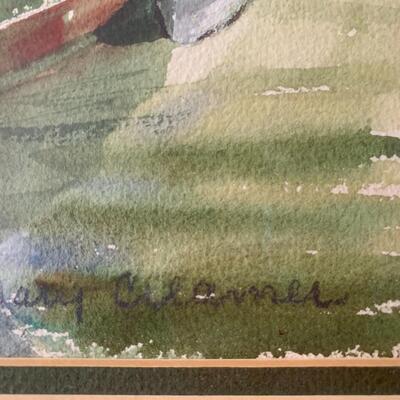
A timeless painting of a sailboat at the dock. Scroll down to read Mary Creamer's bio. \/ Painting measures: 7 1/2' wide x 10 3/4" height Frame measures: 13 3/4" wide x 17 3/4" height American artist Mary Creamer, active ca. 1925 - 1975, was a teacher and painter of portraiture, the figure, still-life and landscape in both oil and watercolor. Absent any birth, census (pre-1940), marriage, or death records in this name, Creamer's biographical details remained almost wholly hidden, and details of her artistic career not pursued, until the recent September 2011 location of a painting signed "Mary Creamer" with an original label verso bearing her un-wed sister's name.(1) Mary Creamer was born Edna Pearl King to James Robert King and Leona L. (Weldon) King in Hart Co, KY on 23 April 1892. (2) Her seamstress mother, Leona, by 1910 twice divorced and single, had moved with her two daughters Edna "Mary" and Bernice, from Kentucky to Indiana. In that year (1910), Mary, age 17, was boarding with Indiana friends living in St. Louis MO. It was evidently there where she met the Missouri native Charles P. Creamer; they were married on 14 April 1914. (3) The youthful Creamer took her earliest instruction in art in St. Louis, at Washington University; but it was sometime after 1920, following relocation to Oklahoma City, that during a lengthy hospital stay - when medical wisdom predicted a virtual certainty of losing her eyesight and perhaps her life - that Creamer was sustained by a commitment to becoming an artist, and immediately upon release entered the School of Art at the University of Oklahoma (Norman).(4) Creamer's Church in the Oil Fields, painted in her first semester there, took a second prize in a state show; impressed by the young artist's talent, instructor Genoa Morris (5) arranged for a local exhibition of Creamer's work, at which eighteen paintings immediately sold [LAJ]. From her home in Oklahoma City Creamer would frequently thereafter travel to study, paint and exhibit both in the east and in the west. Early on, in the East, she worked with Margaret Fitzhugh Browne (1887-1972) in Boston: from her Creamer was doubtless able to develop her facility in figure-painting, as well as the floral still-life, in both of which Browne excelled. In addition to time in Gloucester and Springfield Massachusetts, Creamer also took instruction with the noted watercolorist, instructor and author Eliot O'Hara ([1890-1969] likely in New York but possibly Maine). By the mid-1930s Creamer had - on the evidence, typically over summers - begun painting trips in the other direction, first in Taos NM, and soon thereafter in Santa Fe.(6) The call of the Southwest would eventually find Mary Creamer and her husband moving to southern California, sometime after 1941. From there the painterly environs of Nevada, Arizona and New Mexico were relatively accessible; but there, too, in Los Angeles and especially Taos, did Creamer find a supportive and growing community of artists and teachers. Among the latter was William Frederick Foster (1883-1953), a native mid-westerner who studied first with Frank Duveneck in Cincinnati and then with Robert Henri and William Merritt Chase in New York. Foster worked primarily as an illustrator until 1930, and Creamer is likely to have known him from her earlier trips in NY: one is invited to wonder if Foster's influence as an illustrator, joined to the figure training with Browne, was influential in Mary Creamer's execution of In the Land of Nod, said to have "later won no fewer than eight awards in two years, four of them juried in New York." (7) Having moved to Los Angeles in 1932, Foster taught at the Chouinard School of Art and also gave private classes in his own studio: it is presumably there that Creamer took further training from him. Both were active members of the California Arts Association (Los Angeles), as was the younger artist and teacher Nell Walker Warner (1891-1970). Creamer doubtless knew Warner during the latter's years as a young teacher in the Los Angeles area, and perhaps also from their common interests harbor scenes: both had traveled widely, including to Europe but also visiting Gloucester to paint, and when Warner moved north to the ocean-side art colony of Carmel CA in 1952, Creamer spent time with her there.(8) Mary Creamer lived in Dana Point (near Laguna Beach), San Diego, and Banning, but by mid-60s was traveling with enough regularity to paint, exhibit and teach in Arizona, Nevada, and New Mexico that in 1964 she and her husband established a second "permanent residence at her Taos home" [TN1] that summer. It was near this time, "by way of rounding out her ability as a portrait artist," that she learned from the noted painter Henry Balink (1882-1963) in Santa Fe how to "render the flesh tones and physical forms" of native American Indians: her canvas entitled My Son is reported [LAJ] to have won many awards and "prompted the Taos masters to request the same models, [and] the same pose too." In summers she taught classes at Taos, Carson City, and Reno, exhibiting her traditional representational art - portraits, landscapes and still-life - at the Nevada Art Gallery / State Museum in Reno and at smaller galleries there (the Blue Door, Carson Furniture Gallery, the Village Gallery, etc.). (9) In shows, Mary Creamer had as of 1965 won 18 first prizes, 16 second awards, 15 honorable mentions, four purchase awards, three sweepstakes, and others. In 1967 she taught at South Plains College in Levelland TX [LAJ]. Thereafter she was an active participant in the California Art Club, remaining a member through 1979: in the November 1974 CAC show at their Westwood Galleries, she exhibited Window in the Sky, California Landscape, Hawaiian Inlet, and Morning in the Desert. Though sometimes rendering canvases in the impressionist style (see for example her excellent African Violet), Creamer was committed to traditional realist representations of her subjects - this, she said, "because I like God's ideas as they are. No one, anywhere, can improve on nature, and the human body is the highest expression of creation" [LAJ]. Mary Creamer was a member of the National Association of Women Artists (NY), Pen and Brush (NY), the National League of American Pen Women (Washington D.C.), the Springfield Art Association, the Springfield Art League (Springfield MA), the California Arts Club (Los Angeles), American Institute of Fine Arts (Los Angeles), San Diego Art Association, and the Desert Art Center (Palm Springs CA). She was listed in the '60s editions of Who's Who in the Midwest and Who's Who of American Women [TN1]. 197 / 591 -
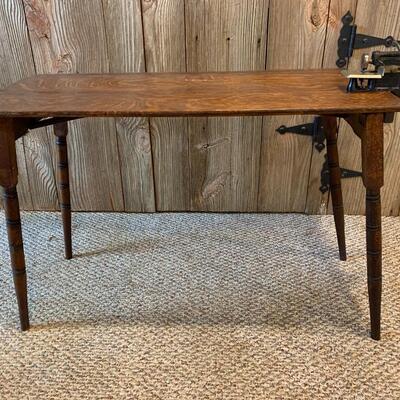
Sewing parties were common back when most women sewed blankets, quilts and clothing. This solid oak portable sewing table is in fine condition to use as it was purposed or as a side table to display photos or collectibles. A handy measuring guide is etched into the table. The Clean Cut antique fabric cutter works great and slices right through fabric. The legs of the table fold easily for compact transport. 198 / 591 sold -

Sewing parties were common back when most women sewed blankets, quilts and clothing. This solid oak portable sewing table is in fine condition to use as it was purposed or as a side table to display photos or collectibles. A handy measuring guide is etched into the table. The Clean Cut antique fabric cutter works great and slices right through fabric. The legs of the table fold easily for compact transport. 199 / 591 sold -
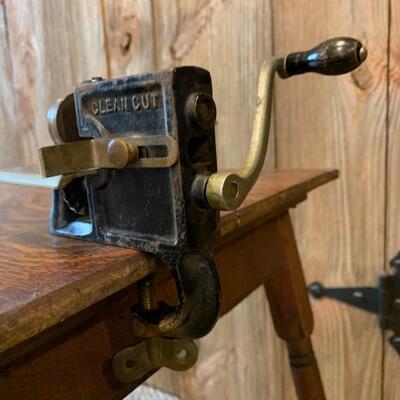
Sewing parties were common back when most women sewed blankets, quilts and clothing. This solid oak portable sewing table is in fine condition to use as it was purposed or as a side table to display photos or collectibles. A handy measuring guide is etched into the table. The Clean Cut antique fabric cutter works great and slices right through fabric. The legs of the table fold easily for compact transport. 200 / 591 sold
Photos 101 - 200 of 591
Per page:
